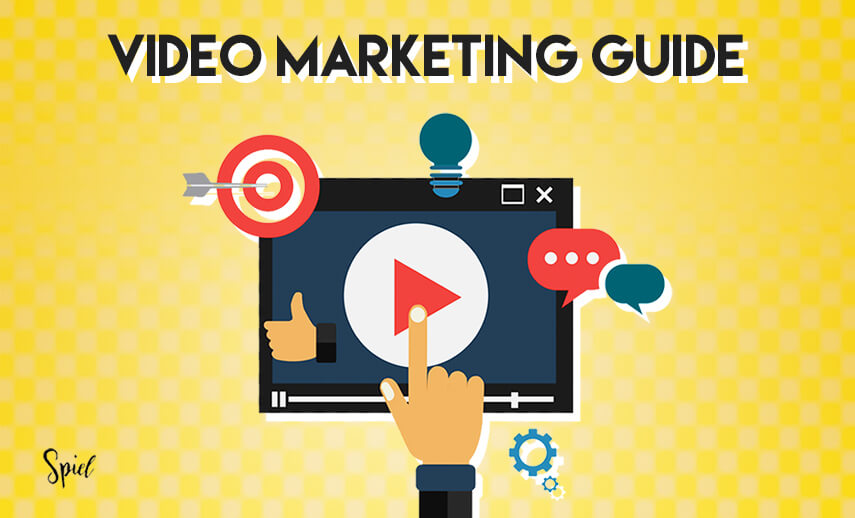
The aim of this guide is to cover absolutely everything you need to know about creating effective video marketing campaigns, beginning with the initial planning and ending with testing and optimising its results.
Why pay it so much attention?
Because, in recent years, video marketing has gone from an expensive marketing strategy add-on to perhaps the most essential component. And sometimes the only component.
Why Has Video Marketing Strategy Become So Important?
The simplest answer: screens. They’re everywhere! If we’re not browsing the web on our work computers, we’re checking social media updates on our smartphones or staring at our TVs.
From a digital marketing perspective, it has become the quickest and easiest way to connect your brand messages with a large audience. So, it’s no wonder that studies have resulted in video marketing statistics like:
- Cisco are forecasting video traffic to fourfold by 2023, making it 82% of all online traffic!
- Ubounce studies show landing page videos can increase conversion rates by 80%.
- Customers want to see videos more than any other digital marketing format.
This all means that if you aren’t creating video content, you’re likely to fall behind. And probably already are.
It might sound like cause for alarm. How can I afford a massive video marketing strategy as a small start-up? And is it really worth the return on investment? you might be asking yourself.
Fortunately, nowadays you really don’t need to spend hundreds of thousands to create high-quality, professional content. Given a reasonable amount of resources, a lot of time, hard work, and the correct approach, anyone can create an effective video marketing campaign that grabs the attention of a new audience and drives sales.
And that’s what this article is all about: the definitive guide to creating video marketing strategies that convert!
What is Video Marketing Strategy?

Despite commonly held beliefs about video marketing strategy, it is not all about knocking out videos until you hit upon the one that goes viral, nor is it as simple as uploading all of your content to social media…
It is the process of creating a holistic video strategy that effectively achieves your desired business objectives.
“It is the process of creating a holistic video strategy that effectively achieves your desired business objectives.”
Video content marketing can be used to explain and promote products, services, and events as well as build brand familiarity, customer rapport, and generally attract attention to your business.
Depending on your circumstances, the videos can be entertaining, harrowing, emotional, logical, hilarious, or whatever you like in order to engage specific audiences directly. And, depending on your needs, they can be published and measured on your website and across numerous platforms such as YouTube and Facebook.
Having an overarching video marketing strategy, where each individual video makes up a small piece of the whole, is vital. It guides the development of the content and helps cement brand identity in the minds of the viewers.
In the long run, it also reduces costs and improves value in comparison to creating multiple one-off videos, due to its strategic approach, greater impact, and condensed production process.
Now:
A Step by Step Guide to Effective Video Marketing Strategy
In this section, I will break down every aspect of video marketing strategy from beginning to end in an easy to digest, step by step guide. The entire process is broken into 4 main stages: planning, production, promotion, and optimising and testing. Any good video marketing agency will provide all of it as part of their service.
Planning

1. Defining Your Video Marketing Campaign Mission
What overall goal do you want your video marketing campaign to achieve? This is a key first step because, if you don’t define what a successful campaign looks like, you won’t have a clear direction going forward.
An example of a good video marketing campaign mission would be to ‘Grow my sales by building a stronger emotional connection with my target audience.’
2. Understanding (Auditing) Your Present Situation
A common early mistake is to start formulating a solution based on preconceived notions. For example, you might think it obvious that a certain piece of content will gain you more website subscribers, but, in reality, it is almost never that simple.
Therefore, step 2 is about taking a step back in order to gain a deep understanding of your audience and conversion funnels. To achieve this, you should collect objective metrics and perform an in-depth analysis as well as do some more exploratory research on your audience and their interaction with your funnels.
Obtaining and Analysing Objective Metrics
Firstly, to gain a comprehensive overview of your conversion funnels, you must gather enough information to map them out in a flow chart.
The flow chart should begin where your traffic sources first encounter your business, say a Google Search or on Facebook, and depict the entire journey they have to take in order to reach the desired objective (an enquiry or a sale, for example).
The journey in between might include a blog post, a service page, your contact page, etc.
Here is a simple example I put together for Spiel (minus metrics):
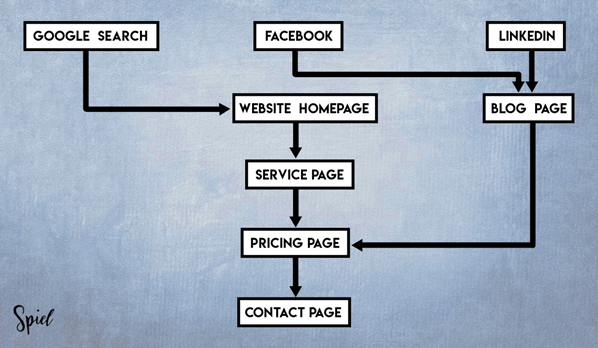
But how do you collect this data?
The best method is Google Analytics. With this amazingly useful tool, you can connect your various social media accounts and video channels and track where your website traffic is coming from and going to.
For instance, it might reveal that a large proportion of your traffic is landing on your website blog page via Facebook, identifying the importance of these posts to your business as a whole.
The goal of every step on your map should be to encourage traffic closer to your desired objectives. For that reason, you should apply the same method to studying click-through rates in order to reveal how much traffic is being lost at each.
For example, perhaps you discover that, once people reach a particular service page, 70% of them then leave the website.
This identifies a major problem with that page and provides valuable information for campaign geography, i.e. where video content should be incorporated into your funnels to increase the click-through rates of certain pages.
Other important factors to measure and include in your map are:
- Bounce rates when people land on your website. What percentage of them leave having not moved on from the initial landing pages?
- Dwell times on each step of your sales funnel map. How long do people spend at each step on average? This will reveal what content is of interest to your audience.
To help optimise your website, the most effective method is heatmap tools.
These are colour key reports of visitor activity and interaction with your website. Warmer colours usually signifying a lot of activity and cooler ones little to no activity.
For instance, if your landing page has multiple videos on it, a red patch over one and not the others signifies that it is attracting most of the attention.
Here is an example of what a heatmap report looks like:

Three of the best heatmap tools currently available are:
Crazy Egg – Best for Traffic Source Mapping
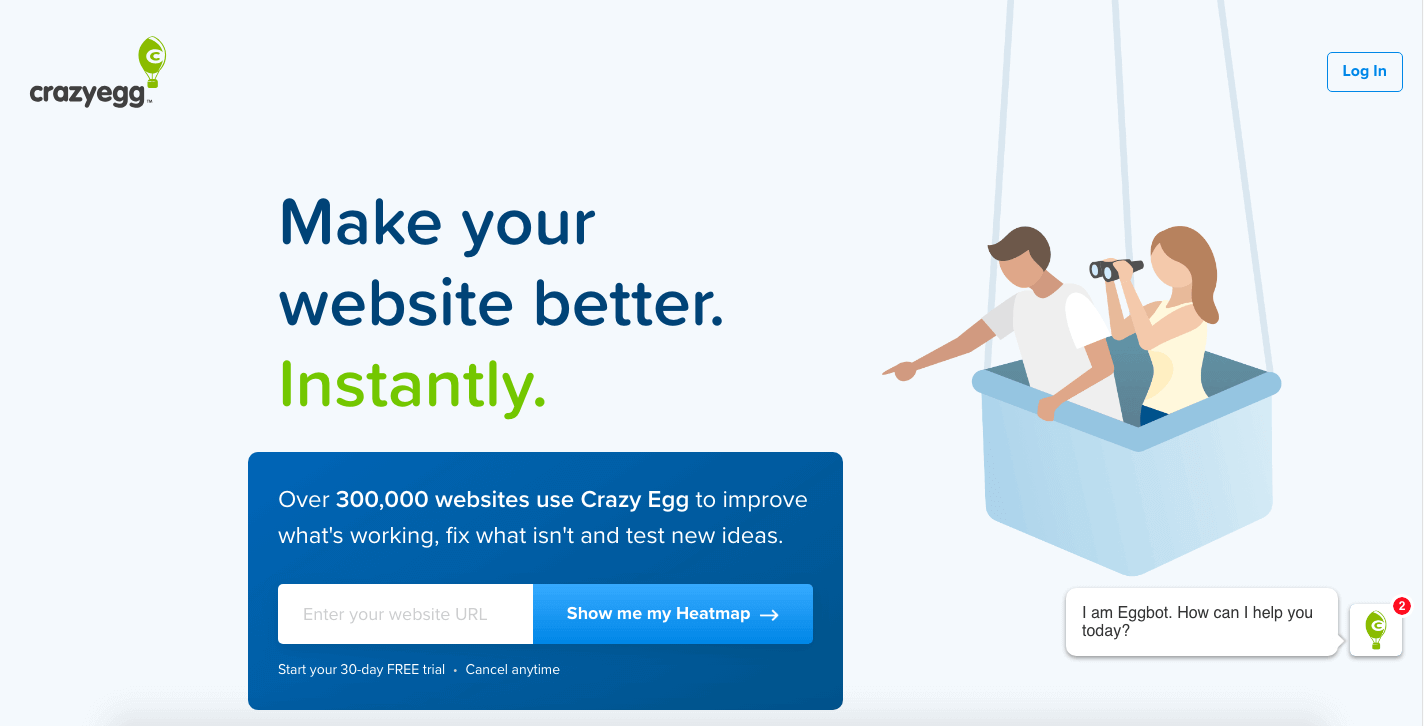
Lucky Orange – Best for Features
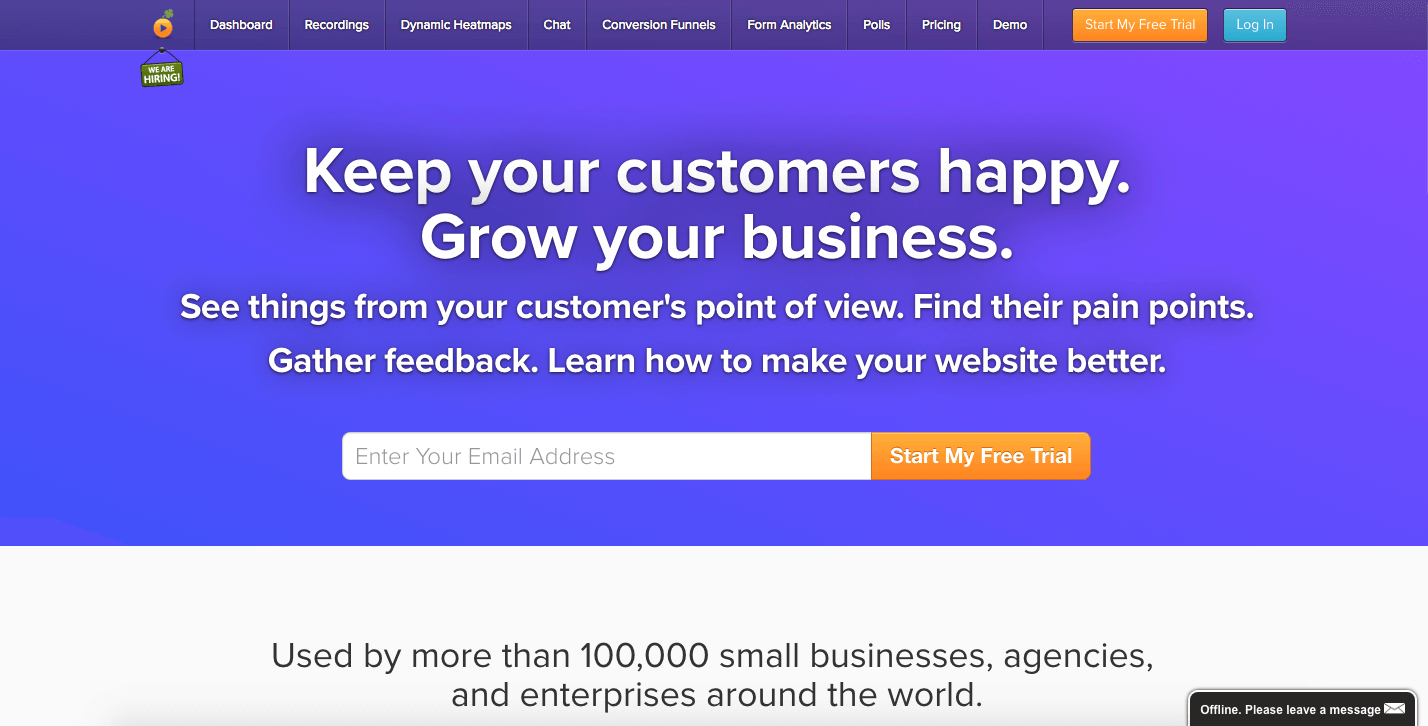
Clicktale – Best for Analytics
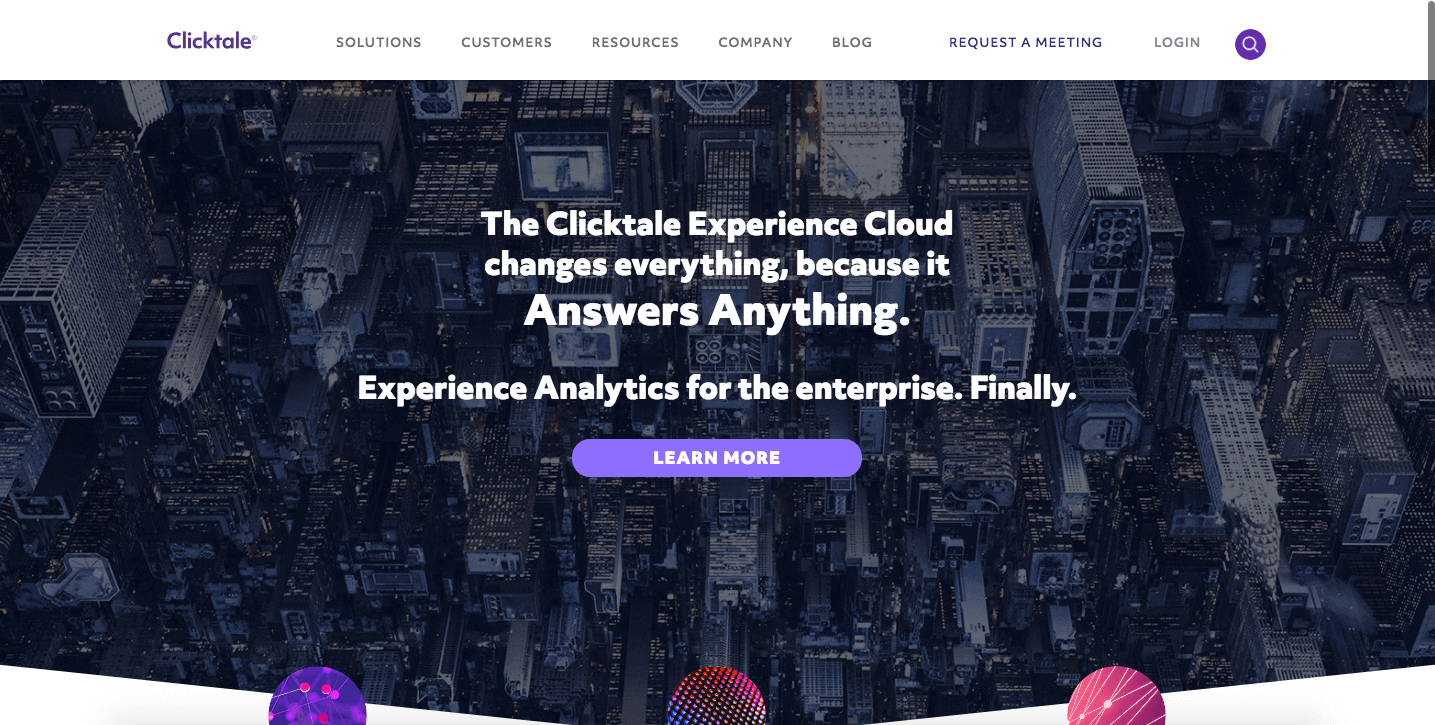
There are several benefits to using them:
- They are a great way to evaluate how visitors interact with your site, converting complex metrics into an easy-to-understand colour pattern.
- They provide valuable information such as where visitors have clicked on each webpage, how far they have scrolled down each, and how, on the whole, they have interacted with the site with eye-tracking tests.
- They help you better understand your target audience by offering key insights into the types of content that engage them and, crucially, the types that don’t.
- They allow you to determine what pages, and where on those pages, new video content should be added in order to maximise engagement and improve the overall design of the website.
Exploratory Research Through Surveys
For a more subjective perspective, perform surveys and study your customer reviews.
Key things to learn here are people’s feelings towards the brand, their general impressions, any common objections they have, and the main demographics that make up your customer base.
When it comes to your surveys, it is important to distinguish between existing customers and new prospects.
For existing customers, you can use tools like Survey Monkey to send them questions that will provide insights into the types of content that they want to see.
Examples of good questions include:
- How did you first find out about us?
- What persuaded you to buy from us?
- What other options did you consider before purchasing from us?
- What’s one thing that nearly stopped you buying from us?
To ask prospects similar questions in real time, you can survey them on your website with tools like Qualaroo.

Qualaroo is easy to set up, requiring you to simply copy and paste their JavaScript to your website code. Then you can start engaging users directly and analysing the data on your intuitive dashboard.
You can find a list of helpful questions to ask here. But these are some of the most important:
- Did you find all the information you were looking for on our website today?
- Does this page meet your expectations?
- What could we do to make this site more useful?
- Is there anything preventing you from making a purchase?
3. Setting Measurable Goals and KPIs For Your Video Marketing Campaign
With the new perspective provided by your research, you can now define the specific, measurable goals and key performance indicators that will have the greatest positive impact on your video marketing campaign mission.
They should be measurable as empirical data will identify the smoothest, quickest route to a successful campaign.
Firstly, it is essential to set the primary end goal for your campaign that is most likely to achieve the overall mission. It might be something like ‘Increase my sales leads by 20%’, for example.
Now you can divide this down further into the specific KPIs that will help reach this goal. For instance, they could be things like ‘Grow my newsletter subscriber base by 40%’ or ‘Over a 6-month period, increase visitor traffic to my website via my YouTube channel by 20 people per day.’
4. Setting and Calculating Your ROI Targets
Before I go into detail, I should forewarn you that there are some calculations to take on-board in this step. I encourage you to take your time when going through it.
And if you have any questions about anything relating to the process, feel free to leave me a comment below this article and I’d be happy to get back to you.
According to Talkwalker, 83% of digital marketings using video think it gives them a good ROI
To come to a realistic estimate for your return on investment from your video marketing campaign, you need 2 important pieces of data:
- The lifetime value of each new customer.
To come to this figure, you need to calculate the average lifecycle of your customers and how much the average customer spends over that time. - The percentage of your traffic that converts to sales.
Now, assigning arbitrary figures to these 2 pieces of data, this is how you would work out an estimated return on investment:
Your KPI: ‘Increase visitor traffic to my website via my YouTube channel by 40 people per day.’
You have measured the following figures:
- Lifetime value of each new customers = £500
- Current daily website traffic: 60
- Current daily sales: 3
We can work out from this that your business has:
- A sales conversion rate of: 3/60 x 100 = 5%
- A total daily sales revenue of: 3 x £500 = £1500
Now, let’s assume your business meets the KPI above (increasing website traffic by 40 unique visitors per day).
This would mean:
Your extra daily revenue post-campaign is: 40 (number of extra daily visitors) x 5% (sales conversion rate) x £500 (lifetime value of each customer) = £1,000
So, a successful video marketing campaign will generate £1,000 extra in revenue per day for your business. Or: £365,000 per year (assuming your business runs 365 days a year).
5. Devising Your Content Strategy

Led by the conclusions of your research and metrics, you are now ready to begin developing a content strategy overview for your video marketing campaign that includes objectives for each video type. The main thing to consider here is how your video content will be incorporated into your sales funnel in order to maximise its potency.
Sales Funnel
The sales funnel is the journey someone has to take to become your customer, i.e. the traffic source map developed in stage 2.
In marketing terms, however, it is often shown to contain 4 distinct stages (as depicted below). To maximise the impact of your video marketing campaign, you need to consider how the videos will leverage each stage so that it encourages as many people as possible to reach the bottom.

A highly effective and convenient model to follow for achieving this is Google’s ‘Hero, Hub, Hygiene’ framework.
The Hero, Hub, Hygiene Framework
Developed back in 2014 as a strategy for growing YouTube channels, it has since proven so successful that it has been widely adopted by companies who now apply across the whole of their marketing strategies.
Hero (Attraction): High-impact videos that introduce your brand to a new audience.
An ideal hero video is a big-budget brand advertisement built around a high-profile event or product launch and creates a strong emotional connection with the viewer.
They sit at the top of the funnel because the attraction stage involves making your business known to as many new prospects as possible.
Hub (Capture and Nurture): Regular, consistent videos that generate brand awareness and trust through engaging content.
To achieve this, they usually tell an interesting story about your brand or explore themes that interest your audience.
They are perfect for the capture stage as here it is important to represent yourself as a thought leader within your industry niche. Examples include latest industry news vlogs, expert interviews, and influencer videos.
Once visitors have reached nurture, it’s important to quell any final doubts they might have at this late stage in the funnel to increase your chances of a sale. For that reason, customer testimonials and product demonstrations are perfect.
I will go into detail about each of the video types mentioned here later in the post.
Hygiene (Attraction): Videos that cover content sought-after by your target audience, ensuring you are present when they search related terms online.
If you run a flower delivery business, for example, and a common question asked by people online is ‘How do I care for roses in a vase?’, then create a ‘how-to’ video explaining just that. When people continue to search this question, they will now be attracted to your business.
To help get your hygiene videos near the top Google search results, you can use their free ad tool Keyword Planner. With it, you can see exact search volumes for keywords as well as estimate and forecast the keywords that your audience will be searching.
Another excellent tool is Ubersuggest. It is a completely free and easy-to-use search engine offering an entire dashboard of useful information.
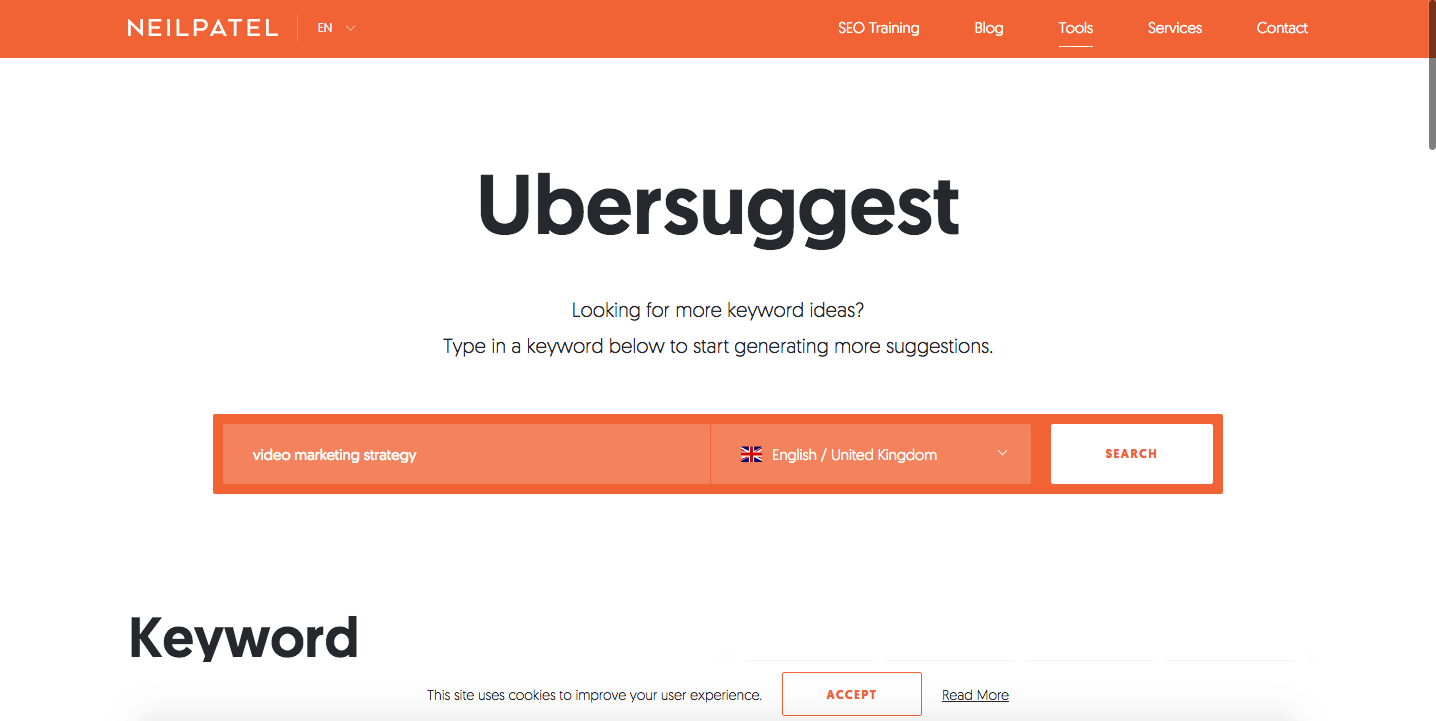
Ubersuggest search results include:
- Search volume for any keywords
- Most searched related terms
- A breakdown of competition for any keywords
- Your chances of ranking in the top 20 of Google for any keyword or phrase

If you want to learn everything there is to know about Hero, Hub, Hygiene, I have covered it all in this article: The Hero Hub Hygiene Framework
By combining your research learnings with the HHH model, you will have no problem formulating a content strategy that plays to your strengths while addressing your weaknesses.
6. Choosing Promotional Platforms for Your Content
Planning where to publish your videos will, of course, depend on your audience’s demographics and behaviours. For example, they might have a strong presence on a particular social network or video platform, which you should take full advantage of.
Each platform has their own best practices for ranking high. So, before planning this content, make sure you have familiarised yourself with them.
Here is a breakdown of key guidelines for 3 of the most popular:
- Before making your videos, ensure that you follow Facebook’s video specs.
- Post your videos between 12 and 3 p.m. (wherever most of your audience are based) for maximum visibility.
- Avoid sharing videos from other platforms (such as YouTube) on Facebook. They hardly ever do well because Facebook, for obvious reasons, only wants users to upload Facebook videos, and therefore rewards them.
By uploading your videos on each platform separately, you can get up to 50 times more views. - When uploading your Facebook videos, make sure you target your specific audience rather than sending it to everyone.
If it’s more relatable to a specific region, for example, only target people in that region. This will increase its chances of going viral. - Use Google keywords in your video titles, as outlined in the previous step.
- Include detailed video descriptions with every upload that also asks questions and encourages interaction. The more interaction you can generate for your videos, the more it will be rewarded by Facebook.
- Most Facebook videos are watched with the sound off, so, to boost engagement, make sure yours are impactful even when muted. The easiest way to combat this is by including subtitles in all your videos.
- Make sure to use Facebook’s build in analytics tools to track how your videos are performing.
YouTube
- Becoming popular on YouTube is all about growing your subscriber base, so, in all of your videos, be passionate and tell them to subscribe.
- As always, use your Google keywords in your titles and descriptions. You should also say your keywords in the videos, but, because YouTube isn’t perfect at picking up everything you say, your descriptions should be a complete transcript of what has been said.
- It is important to keep viewers engaged for as long as possible because YouTube rewards watch time over view count. So, continuously switch up what your viewers are seeing and hearing on screen.
For instance, use multiple locations or backgrounds and incorporate music and humorous interludes. - The majority of YouTube video views comes from ranking high in the suggestions bar, i.e. the videos listed next to any video you are watching.
So, luckily, there is a method called The Sequel Technique that is all about ranking high in YouTube suggestions. And you can learn all about it in this video:
- Follow LinkedIn’s video ad specs when formatting your adverts.
- For maximise visibility, post your videos between 8 a.m. and 4 p.m. on work days, testing to see what time works best for you. And don’t forget that you should go by the time where most of your audience are rather than where you are.
- Like Facebook, a large portion of your LinkedIn audience will watch your videos on mute, so always incorporate subtitles.
- Detailed content descriptions underneath each video and contextual titles are rewarded by LinkedIn. And don’t forget about those keywords.Be sure to measure your videos’ performance with their Campaign Manager analytics tools.
7. Planning the Length of Your Landing Page Videos
When it comes to the length of your videos, the ultimate goal is to make them as long as they need to be in order to best serve the messages and information you want them to convey. Finding these ideal lengths will, of course, involve testing various options to see which perform best.
This is especially important for videos on your website landing pages as each social media and video platform has their own best practices for video length, which I will get to in the next step.
Many comprehensive studies of video length versus viewer engagement have been undertaken and provide valuable conclusions. Notably Wistia’s, which examined 564,710 videos and 1.3 billion plays.
The results are shown in this graph:
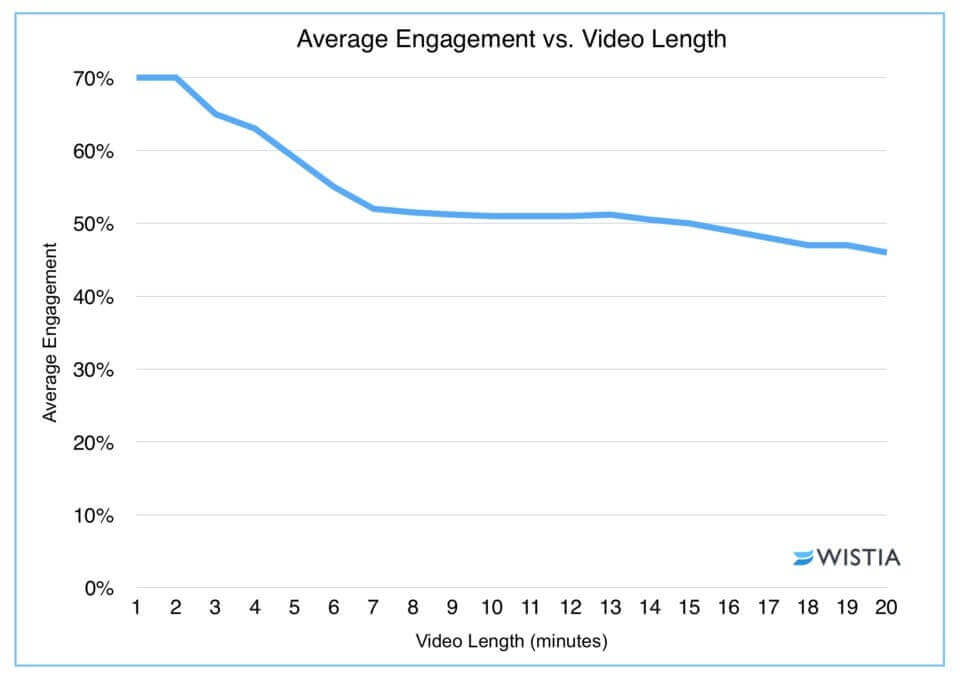
Here are the 3 main conclusions you can draw from it:
- Viewer attention starts to drop after the 2-minute mark. So, unless you have a good reason, it is good practice to keep them shorter than this.
- If someone stays for 6 minutes, they’re likely to stay for 12. So, if your video is 6 minutes long and you’re worried that any longer will be too much, don’t.
- Beyond 12 minutes, you should seriously consider splitting the content into multiple videos.
8. Planning the Length of Your Social Media Marketing Videos

Always study the best practices for video length on each platform you aim to target before making the videos. You will find that each platform’s algorithm favours different factors above others.
Take 3 of the most popular platforms for example:
Facebook Video Length
Facebook’s latest algorithms promote long video content more than anything else, such as text-based or link-based content. Understandably, they want people to stay on the site as long as possible, rewarding anything with ‘Facebook watch time’.
This means that long videos are your best option for attracting attention on the platform. 5 to 10 minutes being the ideal sweet spot between Facebook watch time and viewer retention.
YouTube Video Length
Like Facebook, ‘YouTube watch time’ is one of the most important factors in their algorithm. So, again, your YouTube videos should be long.
If viewers watch 50% of your 8-minute video, for example, you will gain 4 minutes of watch time.
Alternatively, if they watch 75% of your 2-minute video, you are rewarded 1.5 minutes’ watch time.
Therefore, although they have watched a higher percentage of the latter, their algorithm will favour the former.
LinkedIn Video Length
LinkedIn video length is not as important a factor as on other platforms. For optimum performance, LinkedIn themselves recommend brand videos be kept under 30 seconds and more complex videos can range anywhere from 30 seconds to five minutes depending on necessity.
9. Planning Your Content Volume
When working out how much video marketing content to make, it is helpful to refer back to the Hero, Hub, Hygiene framework and how it relates to your business.
Is there one particular video type that would benefit your business’ current situation? What does your target audience want to see, where do they look for it, and how often do they look for it?
Answers to questions like these will inform how much of each content type is appropriate.
For the standard campaign, the hero, hub, hygiene model advises splitting your content into these rough brackets:
Hero: 1 or 2 times a year.
Hub: Daily, weekly, or monthly depending on your means.
Hygiene: Enough to cover all of your key search terms.
10. Deciding How Much You Should Invest Your Video Marketing Campaign
Having already set your return on investment targets, coming to an appropriate budget for your video marketing campaign is relatively easy.
Your budget will, of course, depend on many factors, such as the size of your business, whether you are a B2C or B2B company, selling a product or service, and the scope of the video campaign you want to implement.
To give an example, I will use the current average marketing budget in comparison to yearly sales revenue (7.3%) to work out an appropriate budget for your campaign:
Your yearly sales revenue = £900,000
£900,000 x 0.073 = £65,700
Note: this is just an example of how you would come to an appropriate yearly campaign budget. The 7.3% I have given doesn’t mean much without context.
When it comes to your budget, the important thing is that you apply whatever your specific marketing investment policy is to the overall technique I have demonstrated here.
£65,700 might sound like a lot, but, when you consider that the HHH model recommends implementing a minimum of about 20 videos per year, it can go surprisingly fast.
So, what if you have a much smaller budget?
Well, there are many cost-saving methods that, if followed, can make a small investment go a surprisingly long way.
To begin with, the vast majority of your videos will be Hub and Hygiene.
Interesting, informative, and beneficial content is the focus for these clips rather than production value and impact. Therefore, if they are kept to a simple, consistent, and easily replicable format, they don’t have to be a burden on expenses.
Take video marketing software service company Moz’s weekly vlog ‘Whiteboard Fridays’ for example:
Notice the scale and consistency of their videos. All of them follow the same basic formula: a charismatic narrator using a whiteboard to reinforce their subject.
By applying similar tactics, it will dramatically reduce your production costs and allow you to scale videos to suit your budget. Plus, it leaves you with more for your Hero content.
Another great cost-saving method is to experiment and test everything before committing to a long-term strategy.
“Another great cost-saving method is to experiment and test everything before committing to a long-term strategy.”
In the beginning, try a number of different formats and formulas for your Hub and Hygiene videos. Finding out what works early on will be majorly beneficial for your campaign (and your pockets) in the long run.
11. Setting Your Timeframes and Deadlines

Now that you have planned your content, you are ready to create a detailed schedule that covers a year of your video marketing campaign.
Naturally, once the results have been tested and analysed, you will have to make some changes to it, but it is always important to set deadlines to avoid putting a strain on your expenses.
To give you an idea of the attention to detail required, your schedule should include time for:
- Testing and research
- Data analysis
- Strategic planning (concepts, art styles, marketing, promotion)
- 2 storyboard drafts for each advert
- 2 script drafts for each advert
- Production with revisions (filming, animation, editing, sound design)
- Reviewing and giving feedback between drafts of every step
- Publishing dates
- And back to testing, analysis, revisions, and so on…
12. Brainstorming Creative Concepts and Content Topics
Your creative content and concepts for each video will depend on:
- What message you want it to communicate
- What your target audience wants to see
- Your budget
- What the video is meant to achieve
For your Hero videos, aim to build compelling narratives around your business. The key is to grab the viewer’s attention so that it stays with them and highlights what makes you stand out.
To achieve this, you must create a strong emotional connection by making them either heart-warming, (appropriately) shocking, or hilarious.
And, as I have already mentioned, the content for your Hub and Hygiene videos will generally be guided by Google-search video marketing statistics, trends, insights, and advancements in your niche.
For these, you will focus more on how the stories should be told so that they are engaging and actionable for your audience. How-to guides, product demos, latest news, top tips, and interviews all work well.
Humans crave narratives, so incorporating your key messages into them is more effective at engaging people and creating an emotional connection than anything else.
For example, let’s suppose you are creating a customer testimonial video. One approach could simply involve putting them in front of a camera and performing an interview, asking how they have found your product, etc.
However, a much more effective approach would be to take the camera into your customer’s world and build up an emotive story around your product.
- What problems or issues were they facing before finding your product?
- When they found it, what did they feel?
- How was their experience using it?
- After using it, how did it change their life? What can they do now that they couldn’t before?
Show the answers to these questions in real-world terms rather than just verbally answering them. Just like Guardant Health have done in this video:
13. The Nose/Body/Tail Framework
A highly useful model to be aware of before going any further is the Nose, Body, Tale framework. The Nose is the first 2% of any video, the Body the middle 96%, and the Tale the final 2%.
Nose
Studies have shown that you must hook your audience in the opening seconds or they’ll turn away, and the chances of this happening increases the longer your video is.
Effective methods of combatting this include:
- Getting right to the point rather than starting off talking about yourself or giving a background explanation
- Removing logo sequences
- Start with the result, benefit, or an attention-grabbing fact
Just like PhoneSoap have done here:
Body
If a lot of your viewers stay for the nose and leave during the body, it might be a sign that your videos consist of a lot of boring filler.
This isn’t good because if the body turns them off, they are likely to avoid watching any of your future videos.
Methods of combatting this include:
- Having humorous, shocking, or heart-warming narratives where appropriate
- Splitting longer videos into multiple smaller ones if possible
- Include video pattern interrupts, as outlined in the next step
Hendrix Gin ensured their viewers wouldn’t get bored with this great campaign:
Tail
Often, you will include a call to action at the tail end of your videos, so it can be important to keep people engaged for the whole thing.
To increase your chances, you can:
- Avoid summaries and recaps
- Avoid anything that might indicate the end of the video is imminent, such as a change in music or the appearance of your logo
Brian Dean has this down to a tee:
14. Video Pattern Interrupts
Adding pattern interrupts to your videos is a great way to change things up and keep the viewer engaged and interested. They are especially useful for improving watch time on your longer social platform clips.
The idea is simple: instead of having a clip made up of 1 long scene, break it up with things like:
- Camera angle changes
- Different visuals
- A new narrator
- A new location
- A comedic interlude
- Music
Just like Wistia do in this clip:
15. Formulating Video Call to Actions that Work
A call to action is a request to your viewers to take some form of action. For example, it might be something like ‘claim your free trial, ‘subscribe to my channel’, ‘buy now’, or ‘donate here’.
Every one of your videos should induce the viewer to take action.
Generally speaking, they will come at the end of the videos, but that is not necessarily a strict rule as making them unique and memorable is the number one priority. Perhaps incorporating them cleverly into the body of a video could work for you.
As with every aspect of your video marketing campaign, it is vital to test multiple variants of your CTAs to find what works best.
That being said, here are some general guidelines to follow when creating call to actions:
- You want them to be as easy to understand and follow as possible. For that reason, I suggest having a maximum of 1 call to action per landing page clip. So, choose wisely what one would best suit each video.
- However, the same generally doesn’t apply to social media, where it is common practice to include 2 or even 3 call to actions.
- On social media, you can ask viewers to ‘hit that subscribe button’, ‘like’, and ‘leave a comment’ all in the same video.
- Keep your call to actions short and to the point, avoiding sales pitches that would turn people off. And don’t lead into them with a conclusion or video summary as it signals the end of the video and people are likely to turn away before even seeing your call to action.
- Always articulate the benefits of following your call to action. They can be things like ‘to learn more…’, ‘for your free trial…’, or ‘keep up to date with the latest news…’
- Avoid being generic and make your call to action a unique reflection of your personality. It will boost its performance by separating you from the competition and maybe even put a smile on the viewers’ face.
Exactly like Brian G Johnson does here by asking viewers to subscribe and help feed his two hungry poodles.
- To double the impact of your CTA, always put it on-screen as text while you say it, including relevant clip art such as a cursor clicking a big subscriber button. This naturally draws the viewers’ attention.
- Finally, using power words such as ‘you’, ‘free’, ‘instant’, ‘now’, and ‘easy’ is proven to boost CTA effectiveness.
The 6 Principles of Persuasion
Years of research by Dr Robert Cialdini into the human decision-making process has resulted in 6 definitive principles of persuasion. They are what influences us to say ‘yes’ in any given situation. And when they are applied honestly and ethically to your video marketing content strategy, they can dramatically help to grow your business.
1. Reciprocity
If you want your target audience to take some form of action, first offer them something of value – it’s that simple!
Ideally, it should be personally tailored to them. And, generally speaking, the more unexpected it is the greater impact it is likely to have.
Examples would include a free trial, some valuable information, or a 10% discount for those who sign up to your subscriptions.
2. Liking
People are generally more likely to give a positive answer to people they know and like.
This means that, when you create videos, the narrator or protagonist should be likeable, charismatic, and, most importantly, similar and relatable to your target audience.
Your videos should let the viewer know that you understand their preferences and the challenges they face.
3. Scarcity
This involves basic supply and demand: the less there is of something, the more valuable it is and the more people want it.
When making your marketing videos, first give the major benefits and unique selling points of your product or service, but then focus on what your potential customers gain to lose if they miss out. This cost of inaction will drive action.
If you have a sale on, for example, you could create scarcity by saying ‘Be quick, offer ends tomorrow!’
4. Social Proof

People are far more likely to take part in something if they see others finding value in it.
Imagine you come across 2 restaurants next to each other, 1 that’s packed and another that’s empty, which are you likely to choose? If you’re like most people, it’ll be the busy one.
So, when it comes to your video content marketing campaign, include testimonial videos that show how satisfied your customers are. And, again, they should be relatable to your target audience.
5. Authority
People, for the most part, follow what the industry experts say. So, use them in your videos to support and boost the credibility of your business.
Failing that, appear like the experts you are with positive body language and a confident on-screen presence and delivery.
6. Consistency
Having brand consistency tells people that you are decisive and trustworthy, whereas not having it has exactly the opposite effect. This is important because trust is arguably the biggest factor when it comes to encouraging people to make a purchase.
“Having brand consistency tells people that you are decisive and trustworthy, whereas not having it has exactly the opposite effect. This is important because trust is arguably the biggest factor when it comes to encouraging people to make a purchase.”
In video marketing terms, this means that you should get your website visitors to make some kind of commitment. An example might be something like ‘Try our free 1-month trial.’
After using your product for a month, hopefully it has brought enough value to their lives that they go on to purchase it.
16. Choosing Video Types
No matter the purpose of your video, there is a video type out there to serve it. Here are some of the most common options to consider for your video marketing campaign:
Explainer Videos
Clips that often use a voiceover narrator to concisely explain anything relating to your company, product, or service. Read my explainer video guide to learn more about this type of video.
Variants include training videos. If you want to learn more about them, you can follow this link.
Brand Videos
Generally speaking, clips with high production value that build and attract brand awareness by showcasing a company’s vision, mission, ethos, etc. Just like the ones I outlined for your Hero content.
Educational Videos
Clips made to teach an audience about a specific topic in a memorable and easy-to-understand way.
Variants include infographics and how-to videos. Learn more here.
Case Study Videos
A platform to inform the world about some of the success stories your business, product, or service has brought to your customers.
Variants include testimonial videos, and you can find some of the best testimonial video examples of them here.
Demo Videos
Demo videos explain how your product or service works by replicating the user experience of that product or service. They are vital for your Hygiene content and you can read all about demo videos in this article.
Event Videos
Is there is a big event happening around your business or product? Perhaps a conference, a launch, or a fundraiser? Well, make sure you film it and edit it down to the main highlights. This is a great, cheap way of creating effective Hub content.
17. Choosing Video Styles
When it comes to video styles, there are countless options to choose from. For the sake of convenience, these 4 types more or less cover all your video marketing bases:
Animation
Animation comes in many forms. At our video marketing agency, we produce 2D, whiteboard, 3D, motion graphics, and stop motion. The first two generally being the most popular.
You can learn more about whiteboard animation by following this link.
The benefits of animation are that they have lots of emotion, personality, and humour. They can be a great way to build trust in your brand and they can engage people with complex topics.
Just have a look at this clip, for instance:
As a whole, animation tends to be cheaper to produce than live action. And it also allows you much more room to be creative and ambitious with your content.
On the other hand, it is not as capable of delivering as realistic and personal an experience.
Live Video
Live video (or ‘live action’) uses photography to capture real people or animals, i.e. anything that is not animated. It may be more expensive and restricted than animation, but it is generally more humanising, relatable, and authentic.
Take this clip as an example:
Animation + Live Action
For something uniquely eye-catching, combining animation and live action in the same video can be a perfect way to create a strong and long-lasting brand impression on the viewer.
It may come with a big price tag, but it might just be your best choice for a high ROI.
Take this highly successful campaign done by Argos for example:
Interactive Video
By utilising the latest video technology, interactive video gives the audience the ability to interact and even control the content as if playing a video game. Examples of this include alternative storyline branches and 360-degree view.
It is expensive, but it’s a worthy investment in some instances as it has been proven to drive a 47% increase in time spent watching videos! This huge difference means people are far more likely to remember your brand and its key messages.
Check out this interactive video made by Samsung:
You can learn all about interactive videos here.
18. Creating Effective Video Marketing Channels
To effectively distribute your video marketing content across your channels there are many factors to consider. Thankfully, however, you have already done most of the work in the planning phase.
Having an understanding of your situation, objectives, customers, and content plan will play a role in the layout of your channels. The layout should be comprehensive and cover all of your bases.
- Knowing your situation will tell you where to target in order to improve it. If a testimonial video on your site gets a lot of attention, look into making one for your landing page or an entire webpage gallery dedicated to testimonials.
- Your objectives and KPIs will tell you specifically where your channels should be and what they need to do. For instance, ‘Increase visitor traffic to my website via my YouTube channel by 20 people per day’ suggests a YouTube channel with engaging Hygiene content that drives traffic to your site.
- Knowing where your customers seek relevant content is like a big X marks the spot. If they are regular viewers of a famous Facebook vlog about your niche, team up with the vlogger to create influencer content. A strategy I will discuss in more detail in the next step.
- Your content plan, i.e. how much Hero, Hub, Hygiene videos you are making, will inform any additional channels. If Google keywords play a big role in your traffic, create a dedicated vlog page that drives them all straight to your site.
To simplify your conclusions, you should create an easy-to-read chart that includes all of your video marketing channels. Given the examples I have outlined above, it would look something like this:
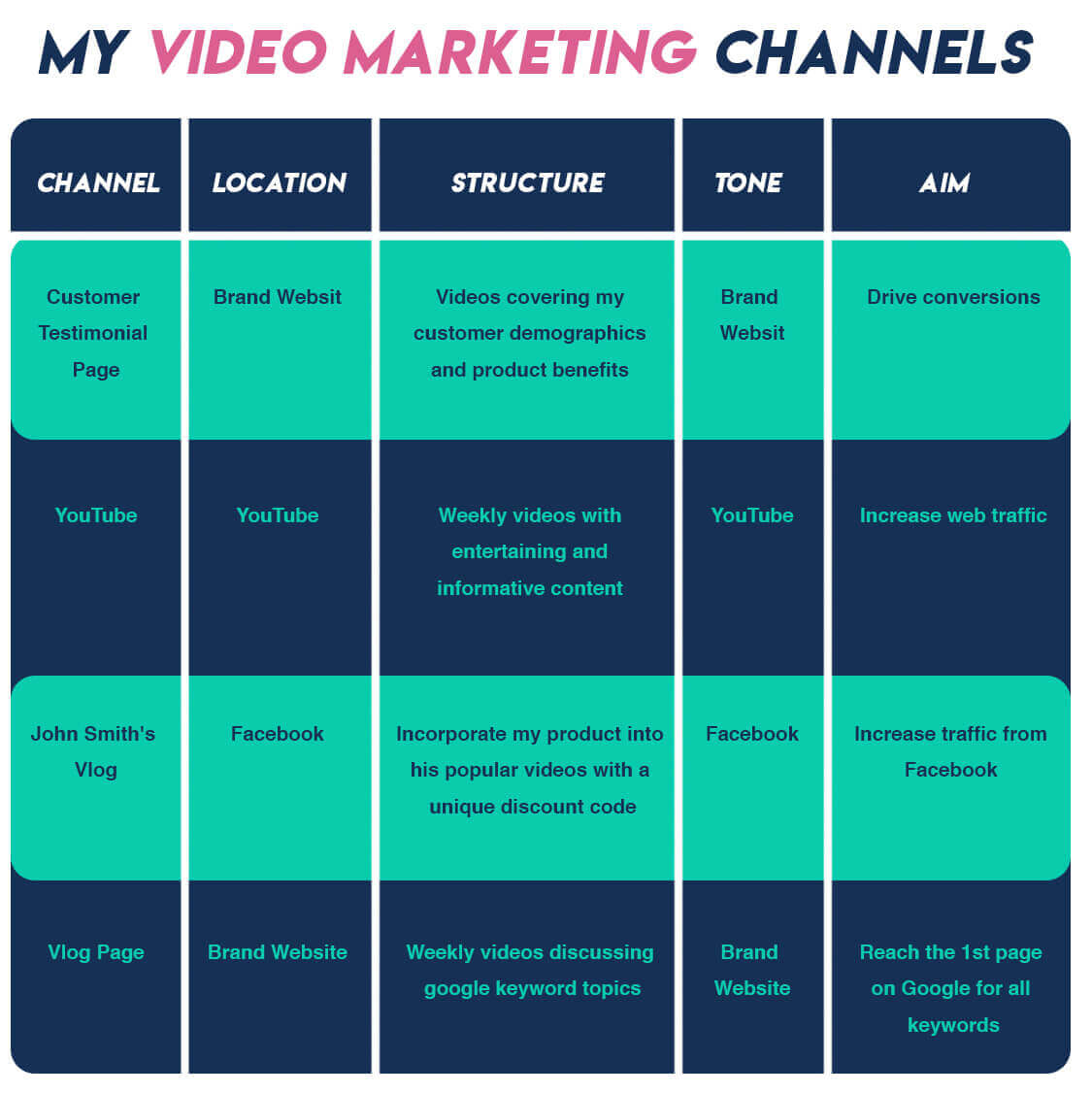
19. Video Hosting Sites
YouTube, while being the most popular, is far from the only video hosting site available. So, here are the 5 best with the major advantages (and a few disadvantages) of publishing your videos on each:
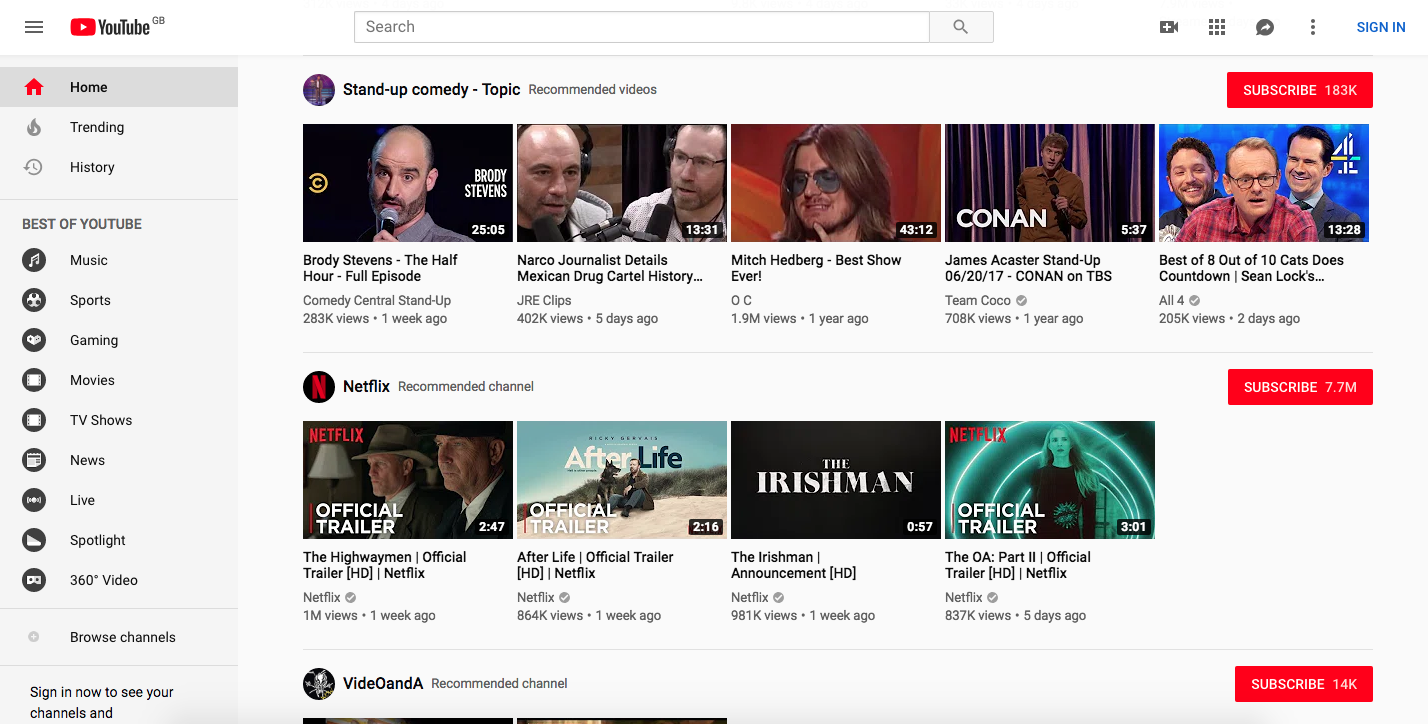
This list wouldn’t be complete if I didn’t include the second largest website in the world (after Google), so I will discuss it here first.
The biggest advantage of uploading your videos to YouTube is, of course, the enormous number of people that could potentially see them. Plus, all of YouTube’s useful features are completely free to use!
These include the ability to grow a subscriber base, making it easy for people to watch each video you upload, as well as the ability for your audience to interact with your business through commenting and liking.
Vitally, YouTube Analytics also comes as part of your channel. This tool allows you to track the performance of all of your content so you can see what is and isn’t working. With it, you can test every aspect of your videos, their length, content, thumbnails, etc., until you find the perfect formula for attracting your target audience.
Their is a downside to YouTube’s popularity, however, namely the enormous amount of competition. Not only does this competition come from other channel videos, but also from paid ads on the platform. It is so distracting and addictive for viewers that it can very tough to drive people back to your website.
Wistia

Wistia is a great video marketing hosting site aimed specifically at businesses.
When it comes to analytics, it is one of the best paid hosting sites there is. Their easy-to-use heatmap and viewer engagement graphs allow you to identify viewer habits with great accuracy and are designed to help drive actionable optimisation.
Wistia has some unique features that help drive traffic to your site. For instance, their ‘gating options’ allows you to insert links or questions within your videos that viewers have to interact with in order to continue watching the video.
They also make is as easy as possible for people to share your content with highly visible social share buttons around all of your videos.
The only downside is that it can be expensive if you require a lot of bandwidth.
Vimeo

Vimeo is the second largest hosting site after YouTube, though still way smaller, and it is also completely free.
The benefits of using it above YouTube are that it has a reputation for hosting more stylish and higher-quality content. So, choosing them will likely depend on your audience and the message and aesthetic you want your brand to convey.
That’s not all: Vimeo is also the better platform for getting people to engage with your content and driving them back to your website. This is because it has far less ads and competition to distract them. And, if people go on to Vimeo, they’re usually there for interesting, creative, and specialist content, rather than looking for a random video to cure their boredom.
Premium options are also available on Vimeo for business. The benefits include more storage, in-depth analytics, customer service, and lots of helpful tools.
The downside being, of course, that it doesn’t get near as much traffic as YouTube. So, the Vimeo versus YouTube question is really a quality versus quantity one. However, they’re both free, so there’s nothing stopping you from doing both.
Brightcove
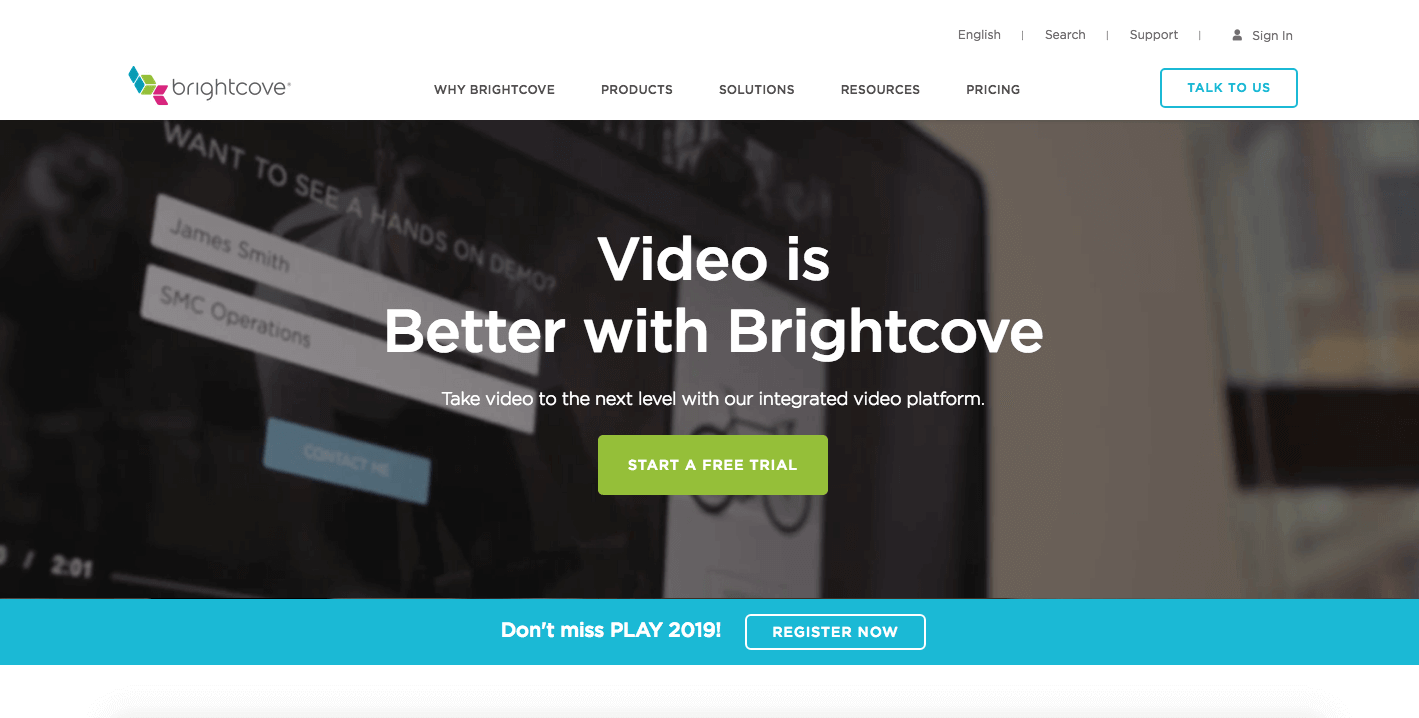
Brightcove is a popular hosting site that is designed to effectively deliver and monetise businesses’ video content.
It is ideal if your content is more varied in form as they offer advertising, live event streaming, lead generation tools, mobile optimisation, branding features, and advanced analytics across a wide range of platforms and devices.
Brightcove’s marketing service helps brands deliver content that effectively leverages every stage of their customer’s journey and sales funnels.
The only downside of all this is it can be expensive. However, they do have a free one-month trial option if you want to try it out first.
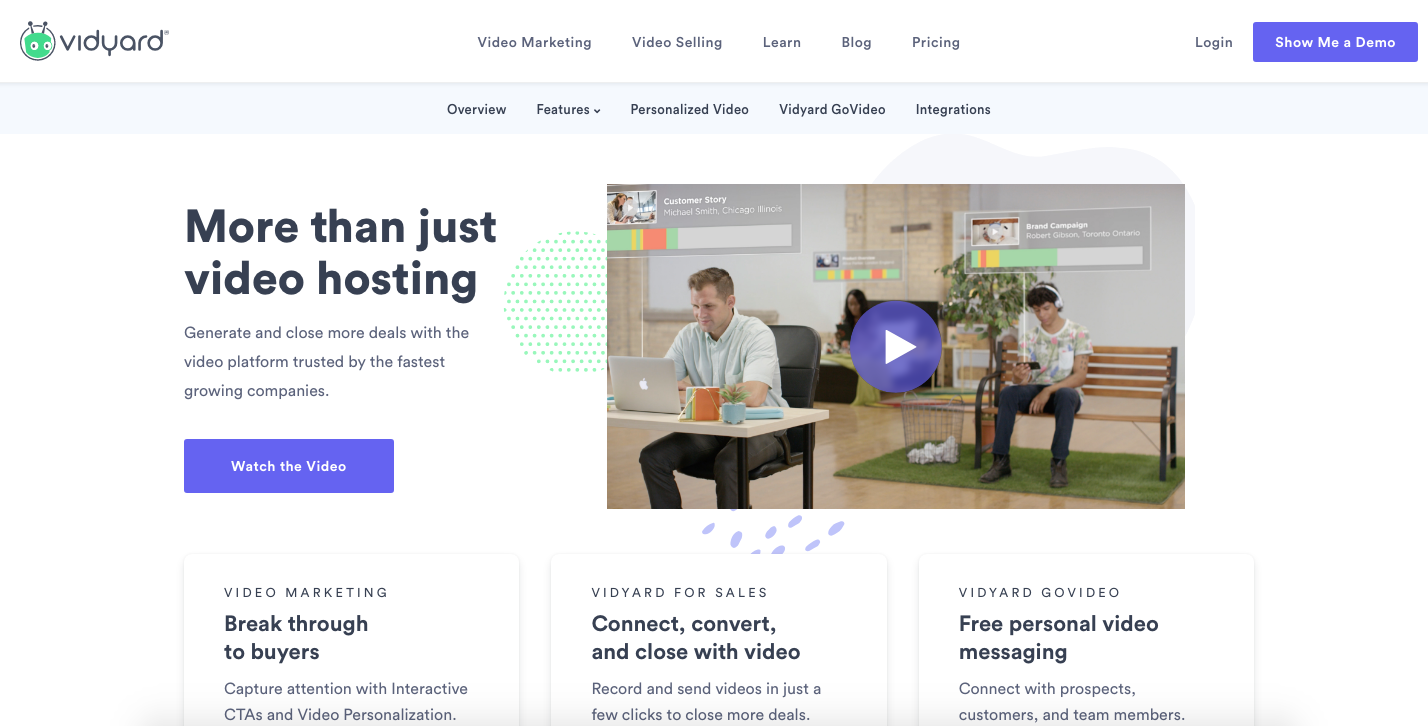
Video hosting platform Vidyard was created especially for businesses to manage all of their video channels.
As this article has thought you, nowadays you need to make make different videos, or at the very least tweak them, for each platform if you want to optimise your performance. For instance, your videos on YouTube should be much longer than those on your website landing pages.
What Vidyard does is act as a single location hub for publishing and managing all of your content across all of your channels. This is extremely useful not only for sheer convenience, but also because it tracks your performance and offers insights that you wouldn’t get from any other site.
For instance, a comparison of your performance across all of your channels that allows you to focus on the biggest wins while ensuring your investment is not squandered in places where it would have little affect on your audience.
20. Influencer Video Marketing
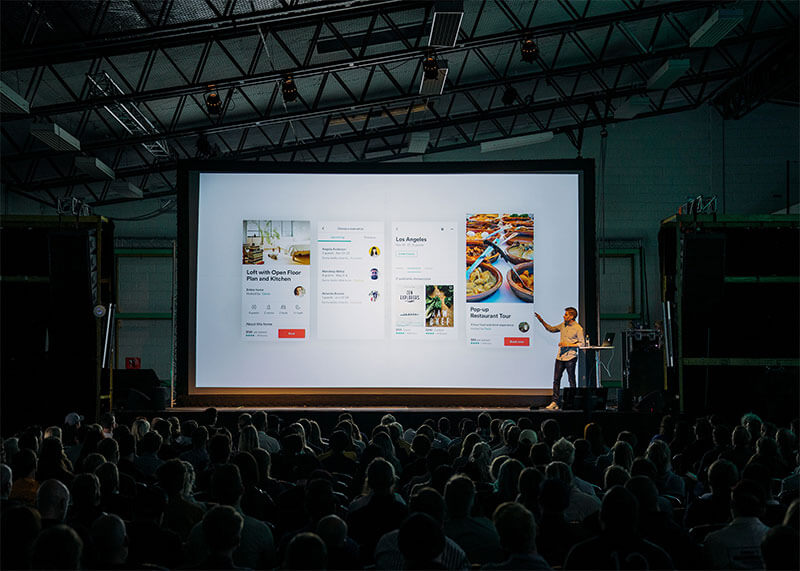
Influencer Video Marketing is the process of recruiting people with influence over your consumer base to promote your product or service through video.
It is one of the biggest and most effective trends in marketing today and you can learn everything you need to know about it here.
In this post, I will give you a short breakdown of the different types of influencer marketing videos and an example of how you can implement them.
Discount Codes
Your company sells all natural food and health supplements. During your research, you discovered that a lot of your audience keeps up with the latest science and health trends through popular video podcasts on that topic.
Here is an ideal opportunity for influencer marketing!
Get in contact with the podcasters and propose sponsoring them and assigning a unique discount code specifically for their viewers.
During their podcasts, they could advertise your brand and end it with a call to action like ‘Go to eHealth today and enter promo code “HealthPodcast” for your 10% discount!’
Their listeners are already likely to be in the market for products like yours. And with the extra incentive of a discount, many of them will inevitably follow it.
Product Placement
You sell hats and sunglasses and are looking to expose your brand to a wide new audience. Well, you’re in luck, because there are hundreds of hugely popular travel vloggers online to choose from!
Associate your products with them by having them wear them in their videos. A large proportion of the audience will naturally ask ‘Where can I get those glasses they’re always wearing?’
Guest Takeover
You sell music software and have a weekly YouTube tutorial channel.
Hiring an industry influencer, say, a respected producer, to take over your channel for a period of time, will instantly introduce your product to a large audience, boost your brand credibility, as well as your leads.
Expert Interview
You’re at the launch of your new B2B SEO tool and there are respected industry experts present who write for major publications.
Interview them for your video content. If they are excited and enthusiastic about it, it will result in a massive boost to your trust and credibility.
Seeding
You sell exercise products and a hugely popular online fitness influencer, whether through sponsorship or of their own accord, dedicates a video to reviewing your product.
These promotions are far more trusted and influential than random celebrity endorsements because people understand that they are industry professionals who hold themselves to a high standard. Their (potentially) millions of viewers are going to take notice.
Affiliate Promotion
You sell a B2B communication tool and use another B2B company’s heatmap tool to help grow your business. It turns out that heatmap company also use your tool for their business.
Here is an ideal opportunity for a free influencer endorsement!
Get in touch with them and propose endorsing each other’s products to your own audiences. Sometimes it can cost nothing to grow your brand awareness.
Production

1. Writing Engaging Scripts
I have already discussed the importance of compelling narratives back in step 12 of planning. The same obviously applies when writing the scripts, so, to avoid repeating myself, I will go into more detail about how to actually achieve this.
Emotional Journey
Educing emotions in the viewer is perhaps the surest way of engaging and connecting with them. Here are some effective way to go about it:
- Show character’s emotions through their actions rather than just telling the viewer what they’re going through.
- Create high-stake situations: a major decision, a life-altering scenario, a time constraint, etc.
- Make the characters and setting as real to life as possible or, alternatively, make them hilarious or shocking.
- There should be some problem, hurdle, or conflict to overcome.
Memorability
There’s no point investing in promotion if no one remembers the videos after watching them. So, here are some tips that might help:
- No matter the complexity of the topic, make your videos easy to follow and comprehend.
- Keep it to the point and cut out any unnecessary and boring bits.
- Show your personality, brand ethos, and unique selling points.
- Hook viewers in the nose of your videos, as outlined in step 13 of planning.
Brand Trust
Building trust in your brand will have a positive impact on conversions. Here’s how:
- Provide valuable, actionable, and informative content that cements you as a thought leader within your niche.
- Encourage engagement and actively interact with viewers’ comments, feedback, and questions.
- Keep your brand ethos, message, and style consistent across all videos.
- Communicate how your brand is socially and environmentally responsible (assuming it is) in your videos and scrips.
For some further useful scriptwriting tips, refer back to the nose/body/tail and pattern interrupts sections in planning.
2. Developing Your Storyboards
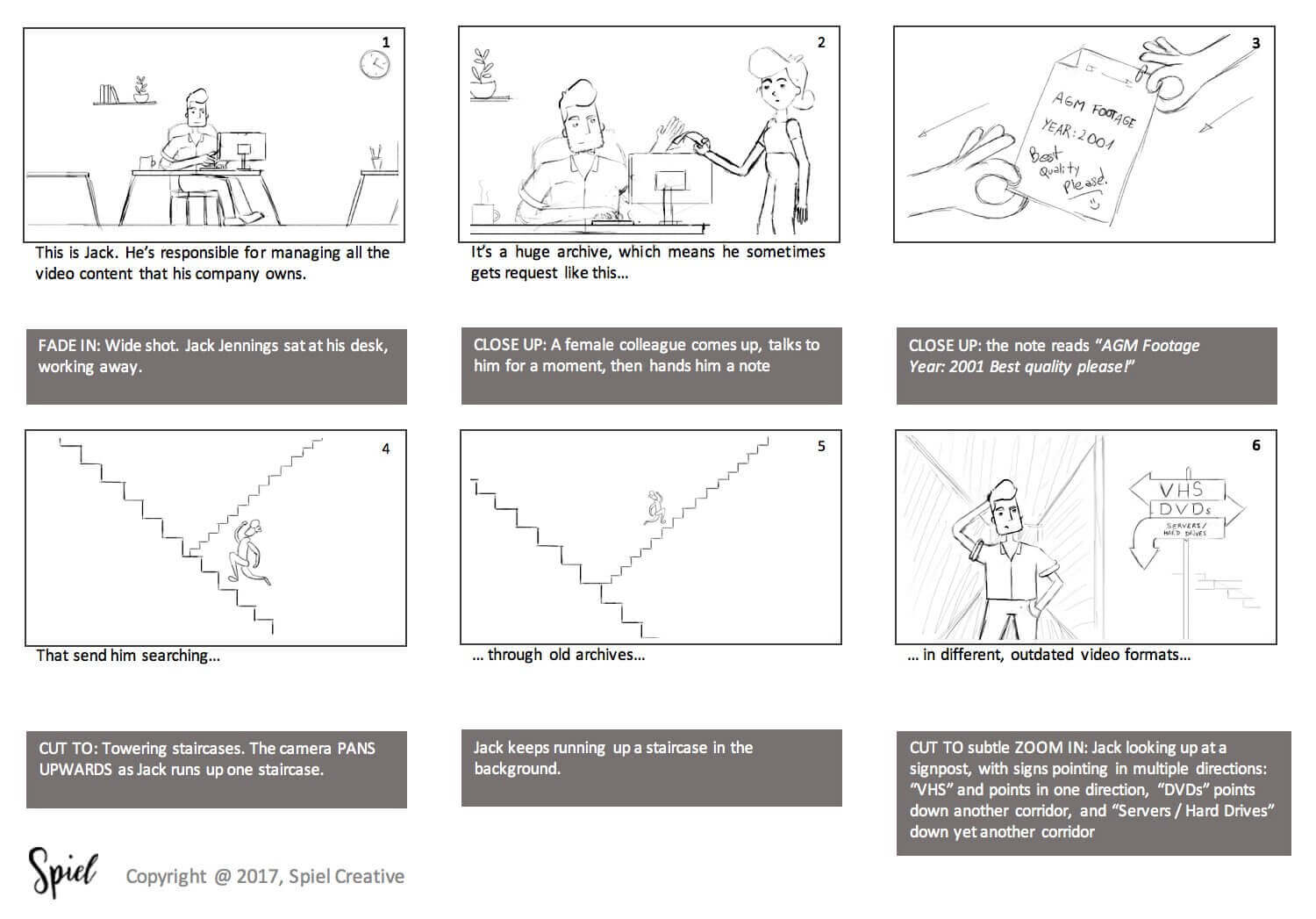
The first step when creating your storyboards is to visualise your script and sketch out each scene as you imagine it. It is always good practice to do a few versions of each.
Then select the ones you like best and that complement each other. Alongside your script, arrange them in a document in the order and position they will appear on screen.
A good storyboard will allow you to see what the video will look like once complete, saving you time by highlighting problems that need addressing before even beginning production.
3. Hiring Voiceover Artists or Narrators
For scripted videos without on-screen narrators, you will, of course, need to hire a voiceover artist to record it.
When choosing one, it needs to be someone who portrays the ethos of your brand. For instance, if you are selling women’s clothing, perhaps it’s not best to have an elderly male voiceover artist. Unless, of course, you have a very good reason or are partial to a bit of irony.
Your research here will be a big help. Are there any clear demographic groups within your audience? Choose someone that speaks to them.
4. Producing Your Animated Videos
Whether creating animation or live action videos, this stage will more than likely involve a collection of specialists working together to produce the content.
This is especially true for your big-budget Hero videos, where you might find yourself managing graphic designers, actors, camera people, sound people, editors, and animators.
If this is all too much for you to realistically take on, I suggest hiring a video marketing and production agency to do it for you. At the end of this article, you can read my top 10 tips for finding the perfect one for you.
Managing your Hub and Hygiene videos yourself is, generally speaking, far more achievable. Though, no matter how simple you have formatted and designed them, it can still be a tough task if you have no previous experience.
In the next step I will discuss producing your own live action videos, but here are the best tools currently on the market for creating low-budget animations yourself. Given a little practice and patience, these video marketing software tools are all relatively easy to use (each comes with clear instructions) and they will allow you to produce some surprisingly professional clips.
1. Vyond
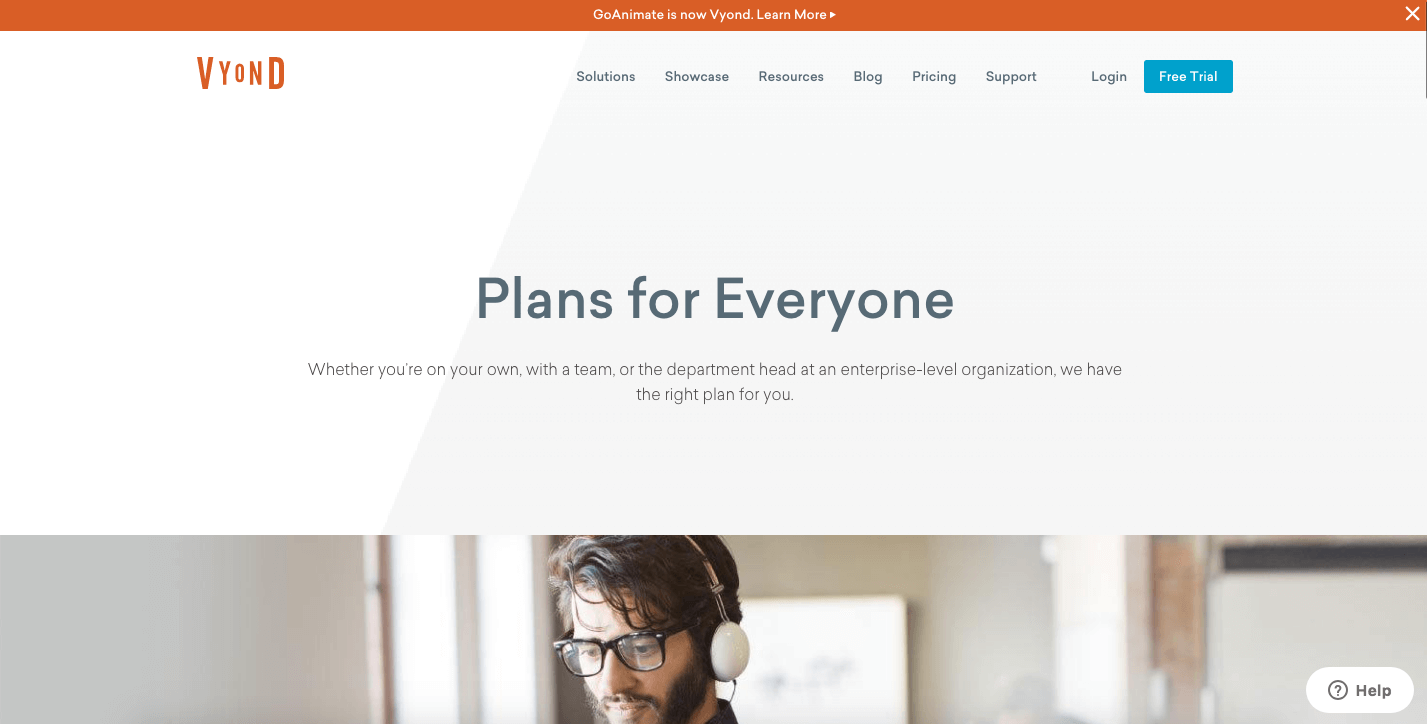
Vyond comes with a relatively large price tag, but, in my opinion, it is the best option if you want to achieve a final product that is as close to a professionally produced video as possible. They do have a free trial option if you want to try it out first.
2. VideoScribe
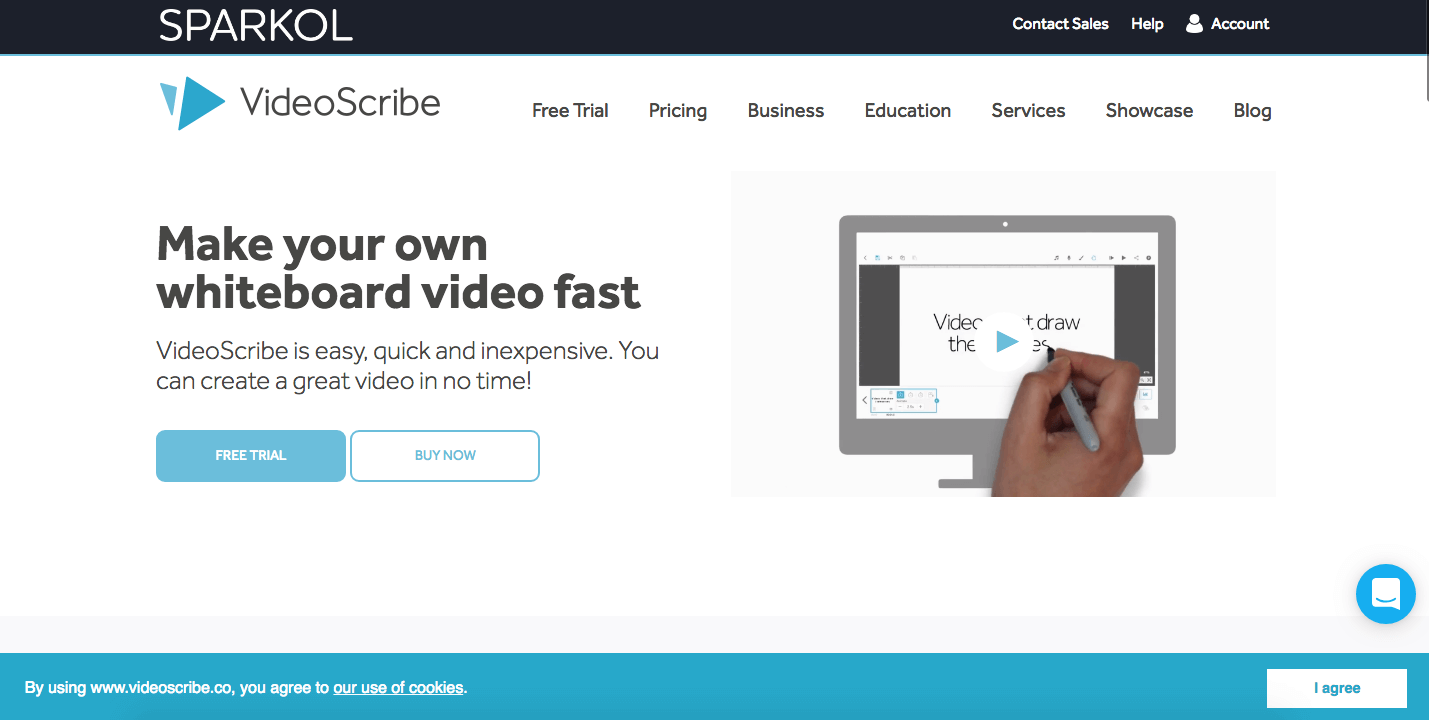
VideoScribe is specifically designed for producing whiteboard animations. It has built-in royalty free images and music, which are very helpful for creating whiteboard videos if you don’t have any prior technical understanding. They also offer a free trial.
3. Wideo
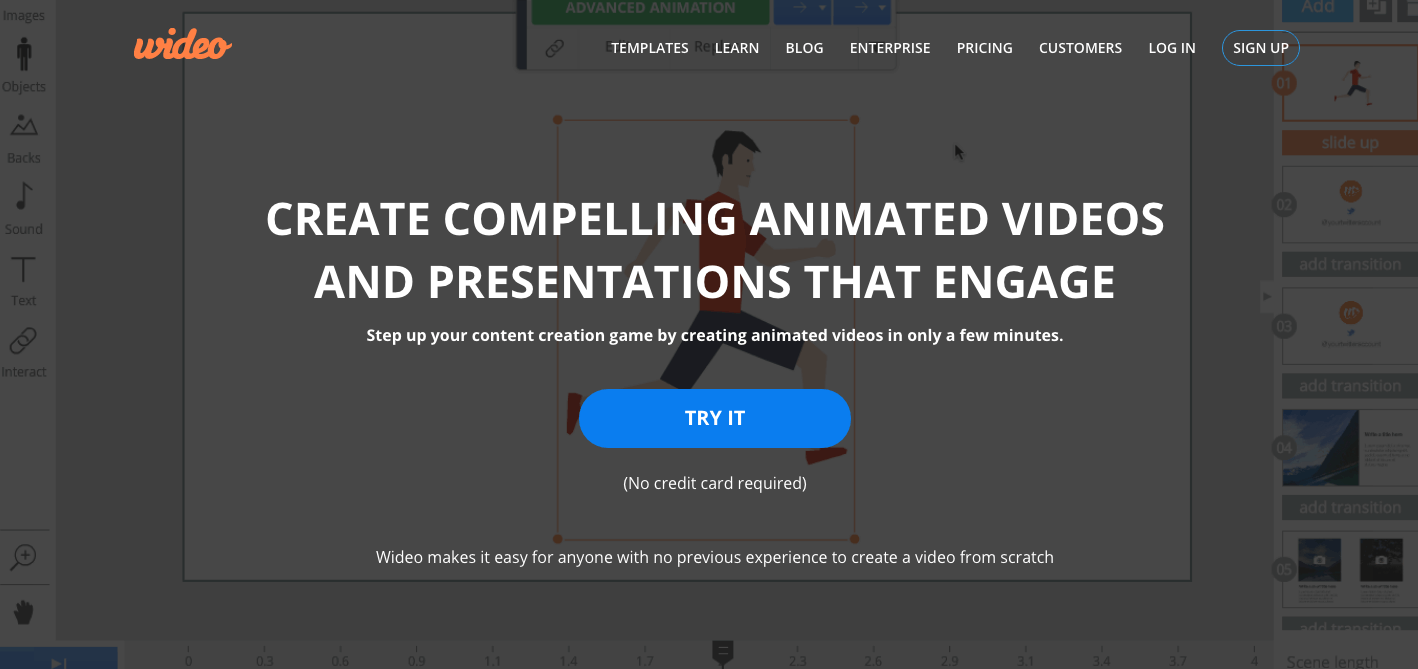
Wideo is an easy and affordable way to create simple 2D animated videos using their intuitive templates. Their basic package begins at $19 a month.
4. Powtoon
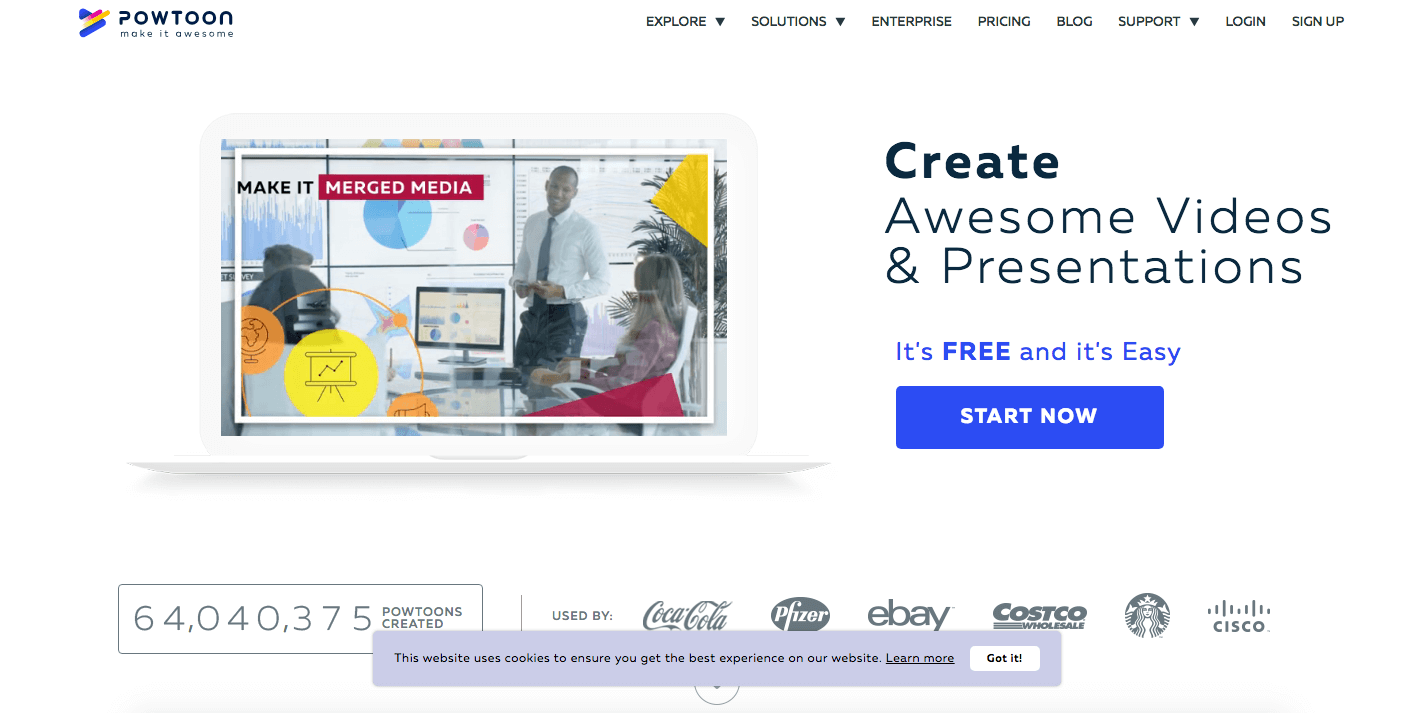
Powtoon makes it extra easy to make animated videos with their great drag and drop tool. And, on top of that, it comes with many template options as well as a free trial.
5. RawShorts
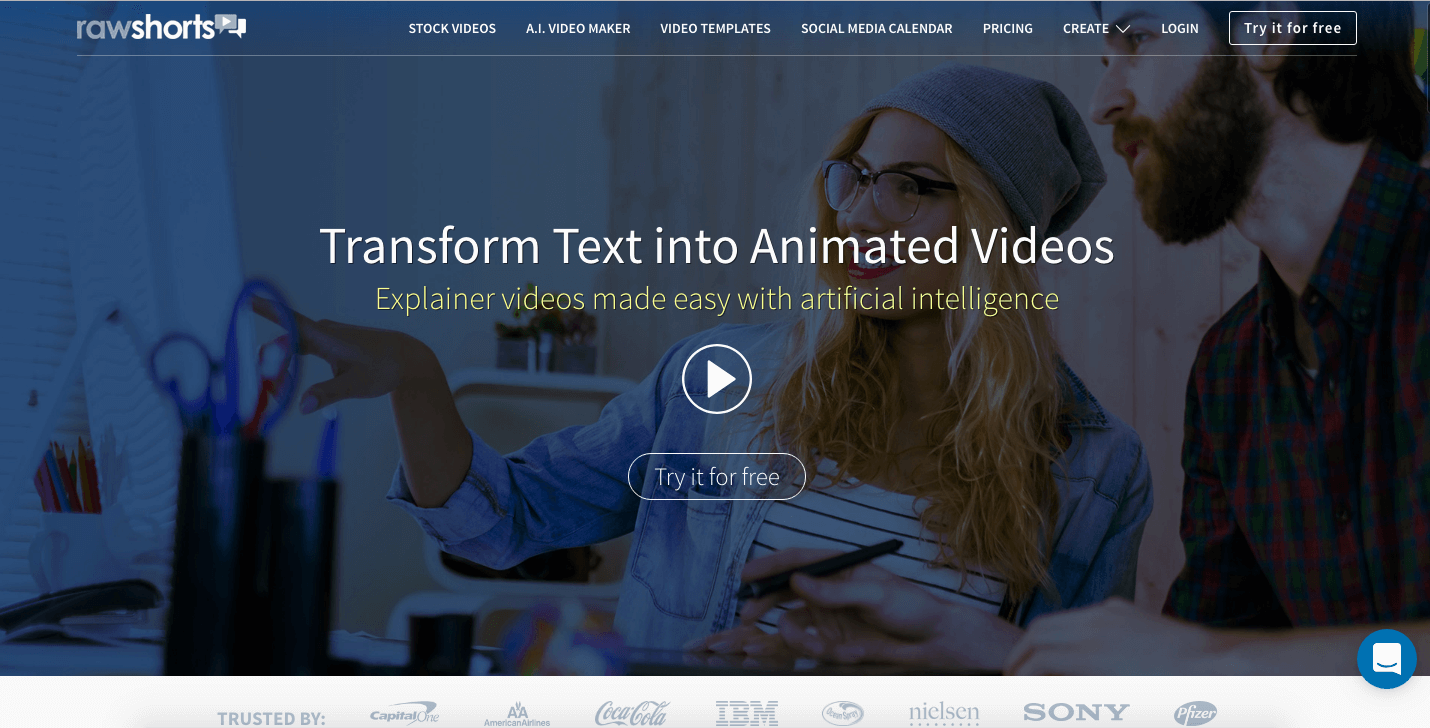
RawShorts is also designed specifically for whiteboard animation. It is perfect for making creative whiteboard animations with sleek, professional-quality transitions. And, yes, a free trial is available.
5. Producing Your Live Action Videos
Despite the biassed advice of every studio in the world, nowadays you really don’t need to hire one to shoot a professional-quality video. In fact, having a more authentic real-world setting can, in many cases, be a massive bonus.
To ensure you are suitably prepared, here is everything you need to know:
Background
- A Quiet Space: Somewhere that is removed from any loud noise.
- Adjustable Light: Preferably choose somewhere you can change the light levels. Even if is just blinds or a dimmer switch, it will be a big help.
- Personality: Use props such as books, plants, a window, a couch, or anything that would add a bit of personality to the shot.
- Set Dressing: But, be sure to remove anything that could distract viewers from the video’s key messages. And, generally speaking, arrange the setting in any way that you think improves it.
Gear
To make filming by yourself as easy and stress-free as possible, this is the gear you will need to rent or purchase:
- DSLR: Preferably one that offers a way of seeing if your shot is in focus. This can be done with either a flip-out screen, external monitor, or laptop connection.
- Wide Lens: 24mm is good.
- Tripod
- Microphone
- Audio Recorder
- External Monitor
- 2 Key Lights
Setup
If filming yourself or an on-screen narrator, place your camera on the tripod and stand it at arm’s length from you or them. It should be positioned just above eye line and pointing slightly down.
Now, plug in the mic, connect the audio recorder, place your lights either side of the camera (also just above eye line), and experiment until you are happy with how the light looks.
Have a few test runs to see if any last-minute adjustments are required before jumping into the script.
Filming
Here’s how to make your life as easy as possible when filming:
- Don’t Sound Flat: Play a high-energy song, go for a run, dance, whatever it takes for either yourself or your narrator.
- Signal Good Takes: Whenever you think you have nailed a take, put your hands over the lens to help find it when editing.
- Record Only What Is Needed: Stop recording every few takes, it will be a huge help when editing.
- And, last but not least, Have Fun!
Prepping Actors

Chances are, if you are producing your live action videos yourself, you are probably not going to have professional, experienced actors. So, here are the measures you should take to make the process as painless as possible:
- Give them a lot of time with the script before filming. However, to avoid adding unnecessary pressure and sounding robotic, tell them they don’t have to learn it off by heart.
- If you have feedback for how they could improve their performance, always counterbalance it with encouragement.
- Don’t be in a serious or bad mood, it will make them uneasy.
- Don’t just leave it at 1 good take per scene. Get a few to give yourself options.
- At the end of the day, film the beginning of the script again. The actors are likely to have grown more comfortable and their acting to have improved.
Filming with Your Smartphone
Cameraphone technology has come so far that there are now even some celebrated feature films that have been filmed with them, notably Sean Baker’s Tangerine. So there’s no reason why, with the correct approach, you couldn’t film your video marketing content with one.
For a start, make sure you have enough storage to film more than you need. And turn off your notifications so you are not disturbed in the middle of filming.
It is more suitable for online videos if you film horizontally, i.e. in landscape view, and, so as to avoid blur, closer to the subject than you would with a professional camera.
If possible, I also advise sitting or mounting the phone one something to ensure there is no shakiness in the final video. And, if your phone allows it, lock the exposure before filming anything.
Wave.video
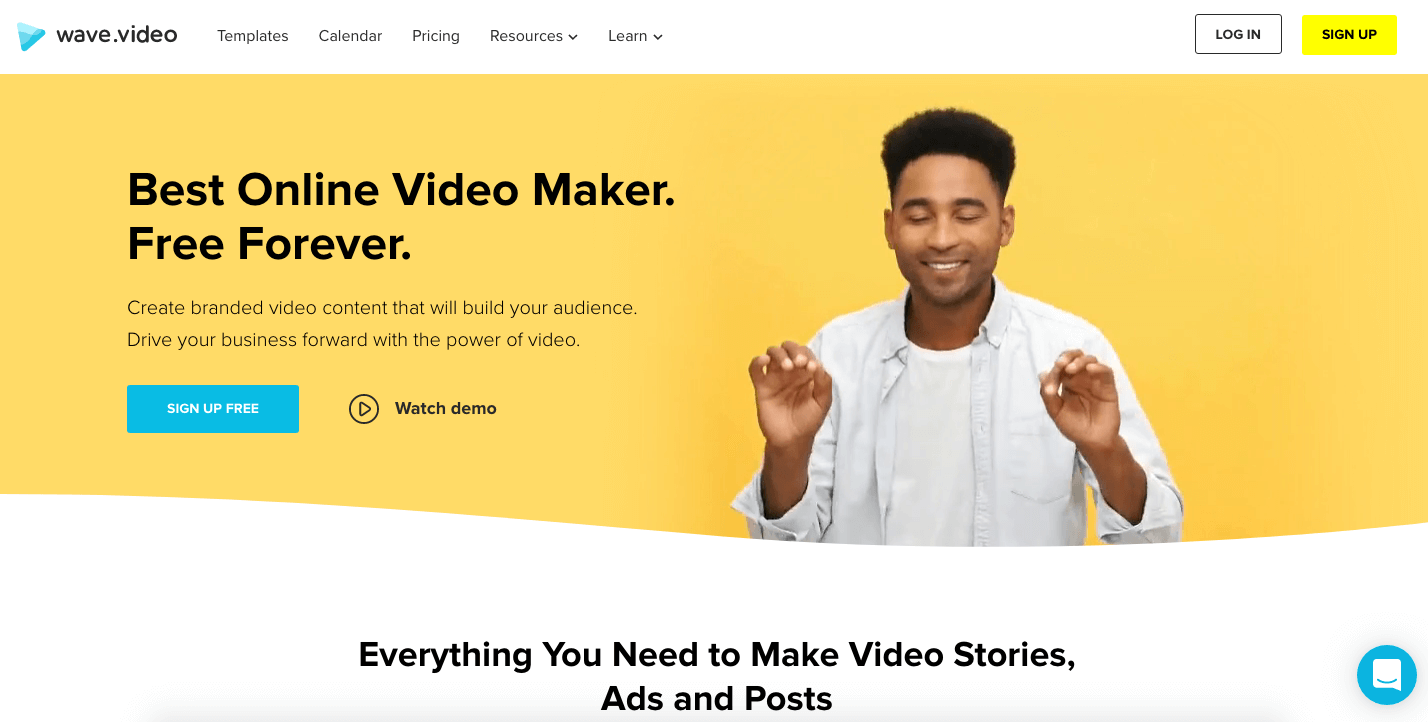
If you want to create live action videos yourself, a great video maker tool to use is Wave.video. With the largest stock video/image library, as well as the option to import and edit your own clips, it makes the production process easy. Plus it’s free to sign up!
6. Adding Sound Design
By adding sound effects and music, you can really enhance the overall perception and quality of your videos. Remember that your viewers want to be transported, and this is a simple but powerful way of doing it.
If your video is in a forest, for instance, incorporate the sounds of trees rustling in the breeze, birds chirping, and streams flowing in order to bring the environment to life.
7. Including Suitable Content Hubs on Your Website
During the planning stages of your video marketing campaign, you may have outlined the need for video hubs on your website. For example, a video blog or a video gallery for your testimonials.
If you don’t set up these pages at this point in the process, you obviously won’t have an appropriate location to publish the videos. For that reason, it’s important to have these page templates ready to go to avoid delaying your campaign going forward.
8. Publishing Your New Content
Luckily, you have already created a thorough plan that includes all publishing platforms as well as your own website. So, this step is easy: publish your videos as planned and get focussed on promoting them!
Promotion
1. Designing Your Landing Page
In order to maximise the click-through rates of the marketing videos on your website landing pages, you should optimise the design of the actual pages themselves. This important often overlooked step can have a surprisingly large impact on your conversions.
Here are the guidelines you should follow in order to encourage as many plays as possible:
- The pages should be minimal, without anything that would distract visitors and prevent them from watching the videos, such as other large images or lots of text.
- Include catchy page headings that offer context as well as some brief text describing the benefits of watching the video.
- Incorporate visual cues, such as a hand pointing towards the video or a person looking at it, to subconsciously draw your visitor’s attention towards it.
- Have an eye-catching thumbnail image for all of your videos. I will talk about the best methods for achieving this in the next step.
- Include a single call to action on each page, one that is mentioned in your videos. It could be a link for a free trial, for example.
Vidyard’s landing page is a good example:
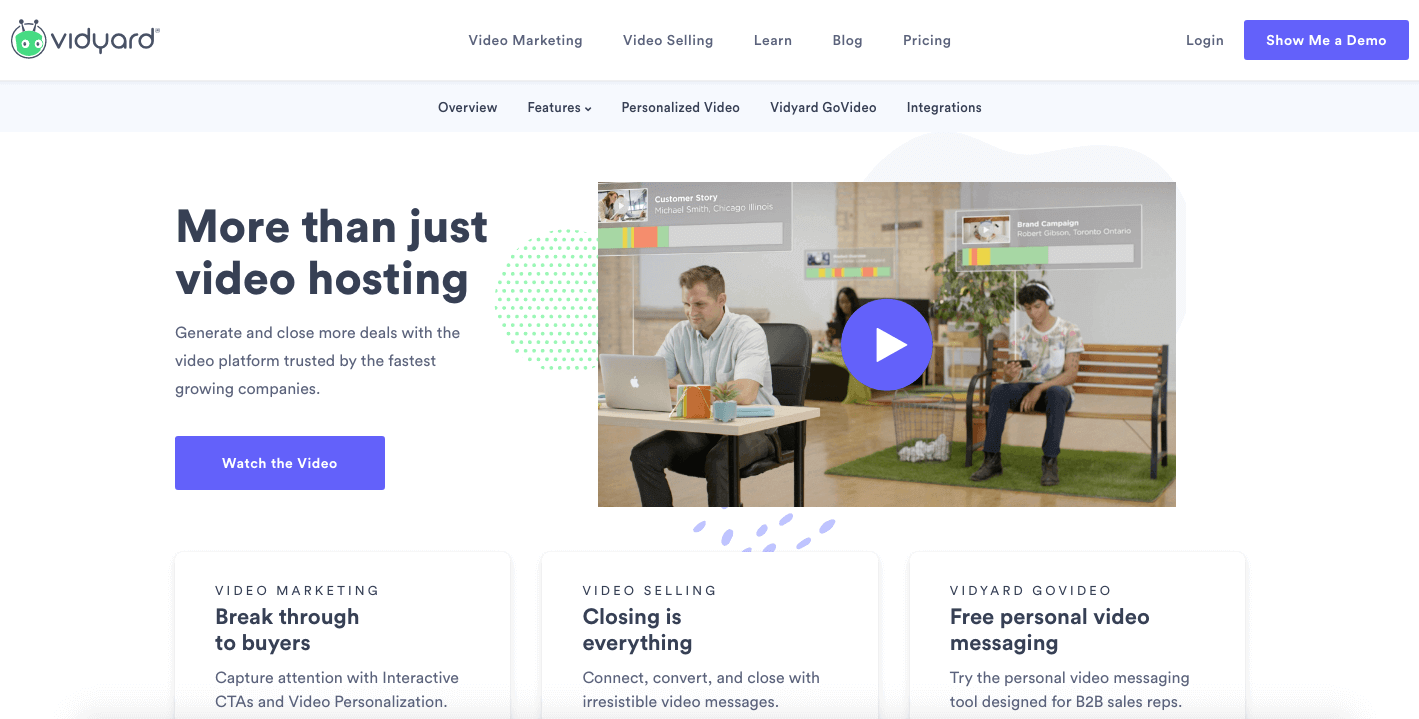
2. Launching Social Media Marketing Content as Outlined
Now that you’ve published your initial content, you need to make sure you stick to the social media schedule you have planned, whether it be daily, weekly, or monthly.
It is this consistency and predictability that will build you a loyal following.
Pay Per Click
One effective way of getting your content noticed at the beginning is Pay Per Click.
This is a form of paid digital advertising whereby your videos appear as ads at the top of user’s feeds and you only pay once they click it. On social media, it has the added bonus of allowing you to target specific demographics.
3. Choosing Your Video Thumbnails
A video thumbnail is a snapshot image from your video that visitors or browsers can see before they press play. They may not seem like something worth your attention, but they have been proven to have a strong impact on video play rates.
Countless studies testing thumbnail images have come to a number of conclusions.
But, just because these conclusions work in most cases doesn’t mean they will in every case.
Therefore, always test multiple variations of your thumbnail images for each video to see what works for you.
That said, here are some guidelines to try for yourself based on those conclusions:
- Use images with bright but non-offensive colours to help your videos stand out in the right way.
- Including a few words of text (preferably 4 or under) that gives the video context also works in most cases. Make sure the colour of the text contrasts the background to aid readability.
Thumbnail Guidelines for Video and Social Media Platforms
The guidelines already outlined apply for both your website landing pages and external video platforms. However, there is one big factor that makes external platforms very different: competition!
Remember, your external video marketing content will potentially be competing with thousands of others all vying for the browser’s attention. So, how is it possible to ensure yours stands out?
One great way to increase clicks is to have a human face showing emotion in your thumbnails.
But, for a more definitive approach, try this method:
Before posting each video, do a search of the keywords you want it to rank for on the platform you are planning to post it on. Then study all of the thumbnail images you see:
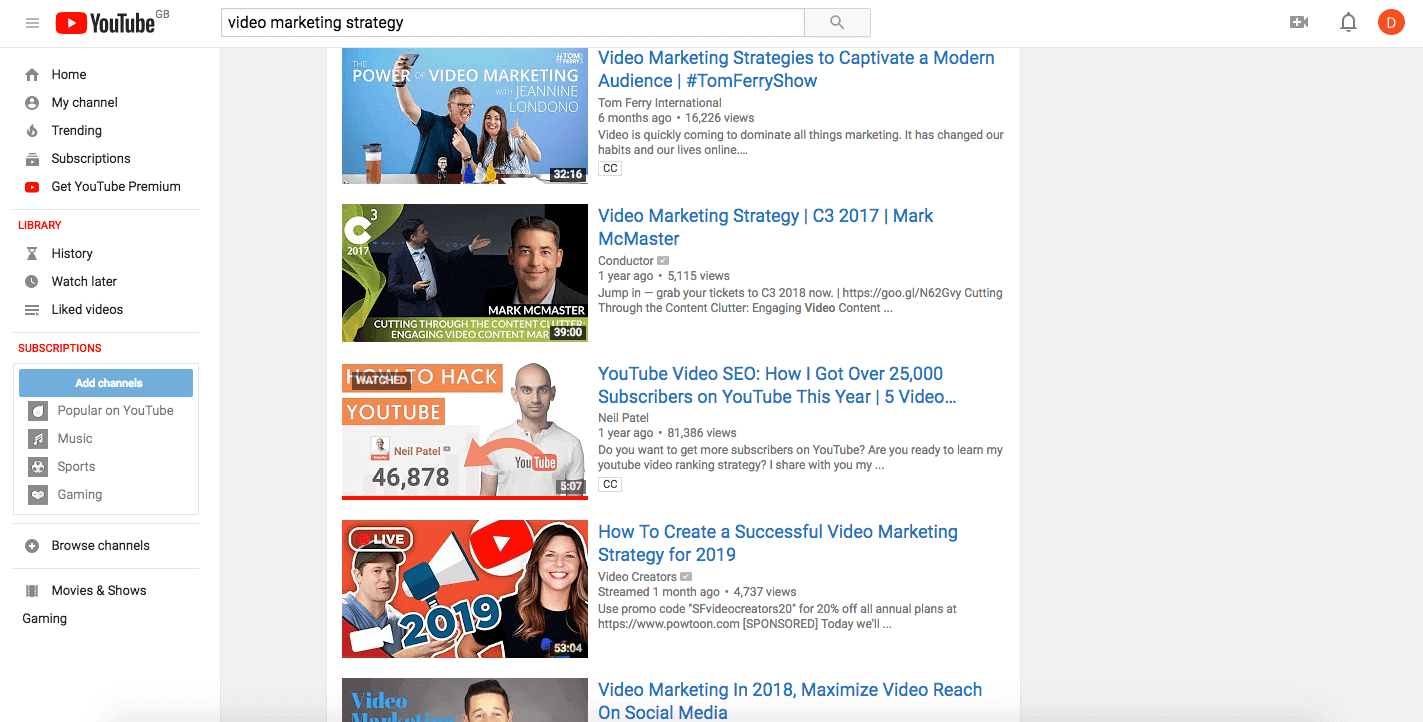
All you have to do now is make sure yours would leap out of the screen if it were placed among them. It might be one of the guidelines I have already outlined or you might need to get creative, but just make sure you differentiate yourself enough to get noticed.
Testing and Optimising
1. Return to Testing
Now that you have published and promoted your content, it is time to go back to the beginning and test your video marketing campaign’s overall performance.
What you should focus on this time around, however, is only that which is related to your video marketing campaign. A new video gallery on your site or a new landing page video, for example.
This will be done in the same way as already outlined in step 2 of planning: by obtaining and analysing objective metrics with Google Analytics and heatmap tools. So, if you have forgotten how this is done, I encourage you to go back to that step to remind yourself.
The results of this testing will either be one of two things: your video marketing campaign has achieved its mission or it hasn’t. But, not to worry, because you’re not done yet!
“The results of this testing will either be one of two things: your campaign has achieved its mission or it hasn’t. But, not to worry, because you’re not done yet!”
2. A/B Split Testing
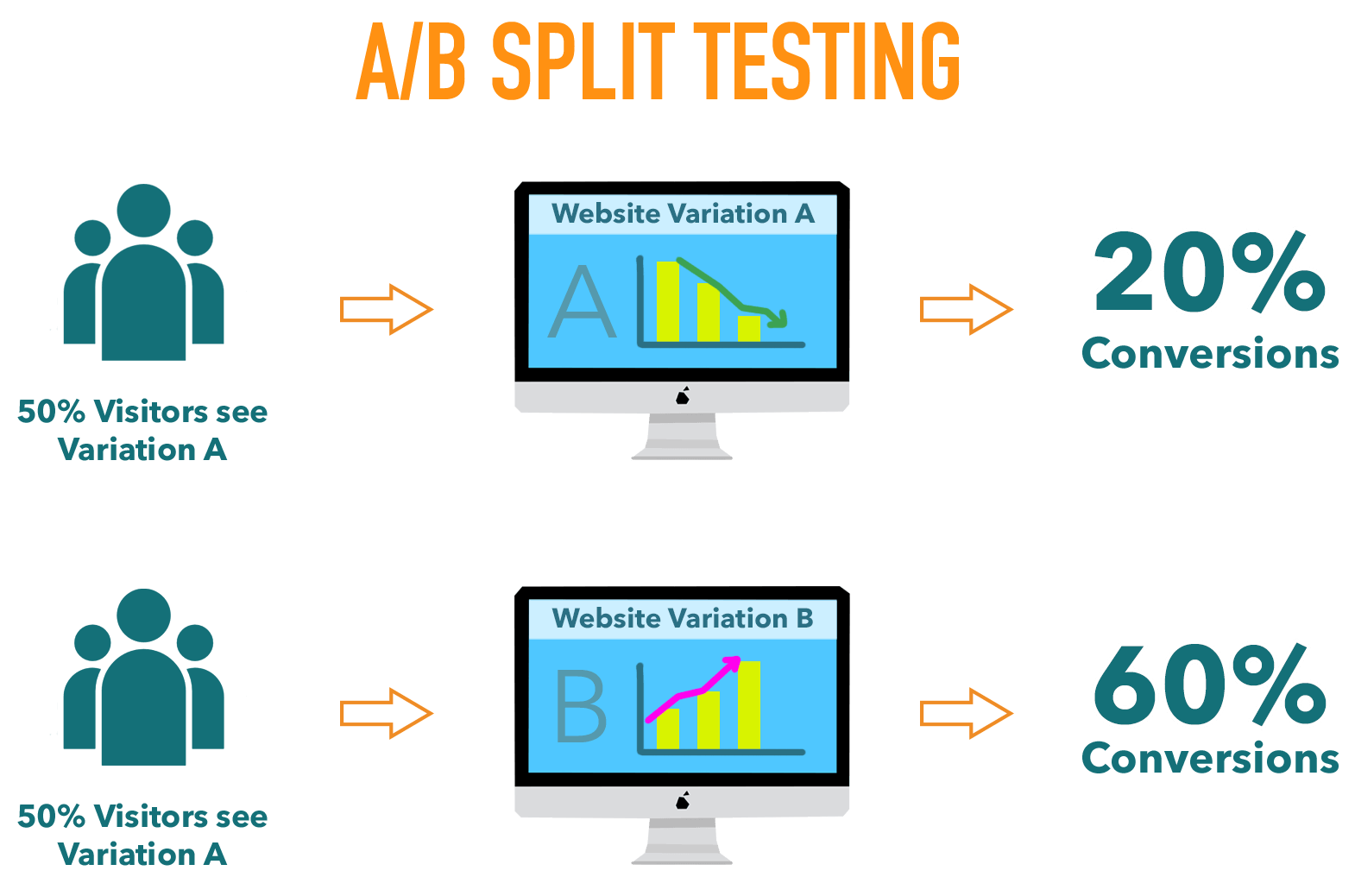
Now you will optimise your video marketing campaign’s performance by A/B split testing. A/B split testing is simple: you make more than one version of something and test each version separately to see which works best.
The three things you will test is your landing page designs, the actual content of the videos, and your posting times.
Landing Pages
Important things to A/B test on your landing pages are:
- The overall layout of the design. Will the video work better if positioned in a different place, for example?
- The copy on the landing page. By changing the video heading and description does that make a measurable difference? What about the font?
- The video thumbnail image. This is easy to change, so try out many and continuously optimise until you find the right formula.
- Any visual cues or other images. Maybe you get more plays without them? Or maybe be more or less subtle with them?
- The call to action. Is it too hard to see? Or perhaps you are drawing too much attention to it and it is turning people off?
Video Content
Which format creates the greatest level of engagement with your videos? To come to a definitive answer, you should experiment with each new one you make.
You can make variations on:
- The length and hook of your introductions.
- Humorous and entertaining versus informative and actionable content.
- Music and video pattern interrupts.
- Call to actions.
- Posting times to see when your audience are most active on each platform.
Over time, testing will reveal what works and what doesn’t. And, given enough time, your video marketing content will become quick and easy to make as well as perfectly optimised.
And don’t forget that hosting sites like Wistia can really help speed up the process.
3. Be Patient
At this late stage in your video marketing campaign, I cannot overstate the importance of patience. It takes time for the algorithms to catch up to the effort you’ve put in.
It can often take 6 months to see any real effect at all. But, once it begins, it will snowball into something truly great for your business.
Should I Collaborate with a Video Agency or Manage the Whole Process In-House?
This is a tough question to answer as it depends entirely on your situation.
After reading all of the steps involved in a holistic video marketing campaign, what does your instinct tell you? Does it seem feasible or are you left in little doubt that you are going to need help?
Good video marketing agencies will be able to collaborate with you on every step of the process. This will result in the most effective campaign possible, while also freeing up your time to focus on the running of your business. For these reasons, if your budget allows for it, I would highly recommend taking this approach.
Alternatively, there might be certain elements of your campaign that you feel comfortable and confident doing yourself and others that you feel you need help with.
For instance, you might need help producing your high-impact Hero content but feel comfortable with Hub and Hygiene. In this case, hire a good video production agency with more specialised skills.
If you decide to do all aspects of the video marketing campaign yourself, just be prepared for the amount of work you are taking on. It is going to require an enormous investment of time and effort if you want it to pay off in the end.
How Do I Find the Right Video Marketing Agency?
With so many video marketing agencies, it can be tough to know where to even begin searching for the one that’s best qualified to collaborate on your campaign.
So, here I have outlined my top tips that will hopefully help you do just that:
1. Outline What Your Campaign Should Achieve Before Contacting Agencies
Not only will this give them immediate direction for your video marketing campaign, but it will also allow you to target agencies who have achieved similar results in the past.
2. Do Your Research
Study all your candidates’ case studies, portfolios, and reviews. Have they got enough experience to manage your campaign? Are you jealous of the video marketing content they’ve made for other campaigns?
3. Prepare a Brief

Before contacting video marketing agencies, prepare a brief that includes your campaign mission, brand ethos, key messages you want to get across, and your maximum budget and timeframe for the campaign.
4. Learn About the Whole Team
Does their skill set cover all of your campaign bases? Project managers, marketing experts, art directors, creatives, producers, strategists, etc.?
5. Be Open to Professional Opinion
If you go into the collaboration with the mindset that you are going to dictate each step of the video marketing campaign, you are guaranteed to reduce its overall quality. You chose the agency because of their professionalism, so always be open to their opinion and find common ground on any disagreements.
6. Be Realistic with Your Schedule
As you have seen, video marketing campaigns can be spread out over a very long period of time. And, on top of that, unforeseen events can occur that delay them, especially during production. So, you should really go into it with the mindset that this is a long-term collaboration.
7. Be Realistic with Your Budget

To a certain degree, you can cut costs on your video styles, etc., but, on the whole, you will get what you pay for. Most marketing agencies are unfortunately not miracle workers. So, to calculate a realistic budget, refer back to step 10 of planning.
Conclusion
- I hope, at the very least, this article has given you a comprehensive understanding of video marketing strategy.
- When formulating your own campaign, remember the importance of the planning phase to the overall success. Take your time when testing and analysing your data to increase your chances of coming to definitive conclusions.
- But don’t neglect the production phase either. The quality of your videos will tell viewers a lot about your brand.
- Feel free to leave any feedback or questions below. I’d be happy to reply!
If you want to consider how to use video marketing to boost your business, then feel free to get in touch with us for a free consultation.


The video marketing is currently the best way to communicate the message to the target audience because it is simple and direct to the point, this article really is a wonder.
Great useful video marketing tips.
Thanks Stephany
Hii Darren, I’m really happy to say it was an interesting post to read. I learned new information from your article, you are doing a great job. Keep Continue!
Thanks for the informative post!
Great explanation about video marketing. You explained everything in simple manner which is really easy to grasp. Much thanks for sharing the same. Keep it up 🙂
Thank you
Hey Darren, fantastic post buddy! Video marketing is a trending online marketing technique, whose success rate is quite high. the strategies that you have mentioned here is really helpful for those who want to create an engaging video that converts. Thanks for sharing this information.
I got some really useful information from your video marketing guide. Thanks
Pretty awesome explanation about video marketing. All the videos you have shared here are worth watching and they made me understand the message you were trying to convey. Thanks!!
Thanks Olivia. Much appreciated!
Hi Darren Travers, Thank you for writing about video marketing strategy. I agreed that video marketing is very important to stay in touch with the targeted audience. It is also very helpful to create brand awareness. Keep writing such illustrative articles!
Thanks for the positive words Priya!
Great Article!!! Thanks for sharing this informative article. This is really very helpful.
Thanks Viral Marketing Hub. Much appreciated!
Hi, Thanks for the information.
Thank you so much for this blog. It was extremely informative. Will definitely help me get further ahead. Lots of useful information here, thanks in your effort!
Thanks Boxfinity. Let me know if I can be of any help!